Cafe business plan template + PDF
In this article, you will find an exemplary business plan for a cafe, offering a detailed framework to guide you through establishing and managing your own cafe. It's crucial to understand that while all names and numbers in this cafe business plan template are invented for illustrative purposes, they can be adjusted to suit the specific needs and realities of your cafe business.
Additionally, for ease of use and customization, a "Cafe Business Plan PDF" is available for download. This article serves as an invaluable tool for entrepreneurs who are keen on developing a robust and practical strategy for launching or growing their cafe, providing a clear roadmap and comprehensive insights into the industry.
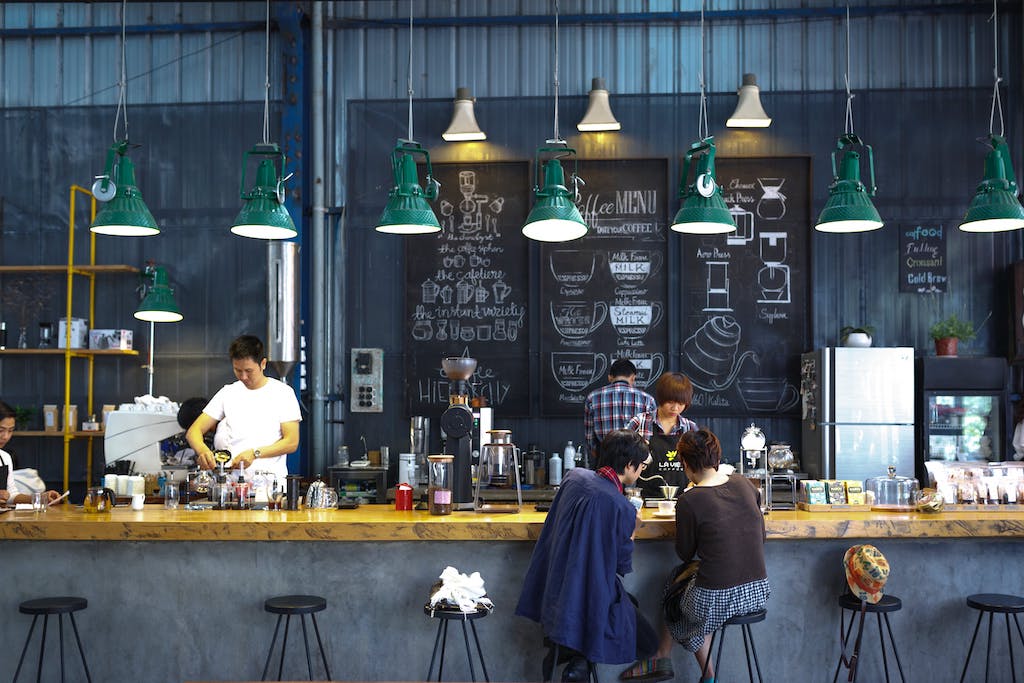

Cafe business plan
How this cafe business plan sample was created.
To create a personalized business plan for your cafe, all you need to do is click on "Get your business plan" . You'll be prompted to answer a few questions about your cafe, providing essential details about your business. Our advanced AI system will then use this information to generate a comprehensive business plan tailored to your specific needs and goals. This process takes only 5-10 minutes, after which you receive a fully structured plan. The beauty of this system lies in its flexibility; you can edit and customize the plan to perfectly align with your vision. Once finalized, you have the option to save it to your computer, ensuring that your cafe/restaurant roadmap to success is just a few clicks away.

Generate your custom restaurant business plan in minutes!
Cafe business plan sample, executive summary, business description, market research and analysis.
- Organizational Structure and Management Team
Products or Services
Marketing and sales strategy, operations plan, financial projections, risk analysis.
In today’s bustling cafe industry, standing out entails more than a robust business model; it calls for a compelling executive summary that captures the essence and potential of the venture. BizCafe is built upon this very vision—a cutting-edge oasis for young professionals and students seeking a coffee experience that is both gourmet and homely, in addition to an efficient workspace. Positioned in the heart of New York, BizCafe is poised to challenge the conventional cafe atmosphere by combining specialty coffees, artisan teas, delectable pastries, satisfying light meals, and indispensable modern amenities like high-speed Wi-Fi and charging stations.
Despite challenging industry dynamics such as fierce competition, economic volatility, supply chain obstacles, and shifting consumer tastes, BizCafe’s strategic plan remains solid. It thoughtfully balances the appeal of our signature products and brand-building initiatives, employing distinctive branding and customized loyalty programs to build a devoted customer base. These offerings are intended to meld effortlessly into the lives of our target clientele, creating a sense of community and loyalty. In the event of heightened risks, our backup plans include diversified menus, local sourcing, and continued product development.
Within a varied competitive landscape that includes Java Junction, The Study Spot, Green Leaf Tea House, and Urban Grind, understanding different market positions is crucial for honing BizCafe’s competitive edge and creating a space that is both unique and adaptable.
Operations form BizCafe’s core, with exhaustive planning that ranges from securing key supplier partnerships to appointing trained baristas and support staff committed to unmatched customer service. Our operational strategies underscore regular quality control, smart inventory management, adhering to health and safety standards, and fiscal responsibility with recurrent assessments and careful budgeting.
Our financial projections suggest a positive outlook. We anticipate reaching a break-even point by the end of the first year and foresee a promising 20% revenue increase by the third year. With the projected growth, we aim to pursue expansion and diversification, setting a course towards a $1 million revenue milestone by the end of the fifth year.
Marketing and sales are integral to introducing and embedding the BizCafe brand in public discourse and consumer habits. An ingenious blend of social media activity, loyalty incentives, local events, and partnerships with nearby businesses is designed to uphold and celebrate the BizCafe ethos. This is supported by a robust digital foundation that ensures convenience through online ordering platforms and sustains community engagement with impactful email communication.
Driving this promising enterprise are seasoned leaders such as Co-Founders & CEOs Alex Taylor and Jordan Lee, who bring a wealth of experience in business management and finance. Operations Manager Riley Kim and Marketing Director Casey Morgan complete the leadership team, guaranteeing seamless operations and strong, consistent brand visibility.
As an LLC, BizCafe benefits from the agility needed to adeptly manage the unpredictable nature of the cafe industry, all while taking advantage of a tax structure that encourages growth.
In conclusion, this executive summary portrays BizCafe not just as another cafe in New York’s tapestry but as a beacon in its cafe culture—a sanctuary for today’s discerning, digitally connected patron and a strategic investment opportunity for tomorrow’s wise investor.
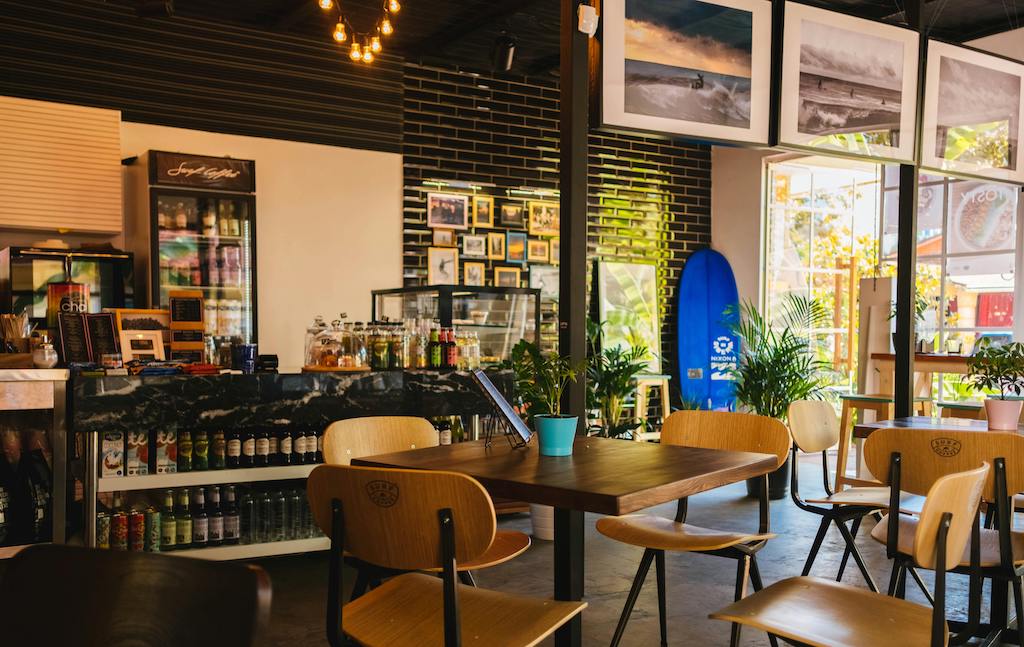
Located in the bustling heart of New York, BizCafe is primed to become the go-to destination for the city's energetic young professionals and the academically inclined student population. Designed as a Limited Liability Company, BizCafe harmoniously balances the vibrancy of an artisan coffee hub with the tranquility of a focused work sanctuary. This innovative cafe caters to the tastes and lifestyles of customers aged 20-35, offering an array of specialty coffees, artisan teas, as well as a handpicked selection of pastries and light meals.
Embraced by the convenience of high-speed Wi-Fi and charging stations, BizCafe is not just a place for savoring a cup of freshly brewed java but is also an inviting space for clients seeking a comfortable place to work, study, or unwind. With a central location, this cafe capitalizes on the fast pace of New York City, becoming a social landmark that facilitates productivity and leisure.
BizCafe prides itself on mitigating anticipated industry risks. Facing competition from establishments such as Java Junction, The Study Spot, Green Leaf Tea House, and Urban Grind, BizCafe differentiates itself through its unique branding and customer loyalty programs. In the event of increased rivalry, the management plans to diversify the menu and enhance loyalty incentives to retain customer fidelity. Economic fluctuations will be met with competitive pricing and value deals, while supply chain disruptions are countered with established relationships and buffer stock, complemented by local sourcing as a contingency measure.
Looking to the next 3-5 years, financial projections are optimistic. The first year is focused on reaching the break-even point, with a revenue aim of $500,000, setting the stage for profit as the brand gains recognition. Steadying itself for moderate growth, BizCafe expects to increase revenue by 20% annually in years 2 and 3 and is planning an expansion that may include a second location or enriched services by year 5, hoping to surpass the $1 million revenue mark.
Within the café, operations pivot around supreme supply chain management, premium staffing, unwavering quality control, and sophisticated inventory management. Staff are selected for their skills and commitment to customer service, with a rotational shift system ensuring comprehensive coverage. In-house financial and customer service processes are evaluated routinely to align with the cafe's high standards.
The marketing and sales strategy is equally robust with a dynamic approach to embrace digital platforms. Social media marketing, loyalty programs, community engagement, collaborations, and a formidable digital presence all form pillars of BizCafe's promotional endeavors. Customized email marketing further personalizes the brand experience, resonating with the targeted clientele.
Leadership is the backbone of BizCafe's operation. Co-Founders Alex Taylor and Jordan Lee embody the essence of keen business acumen and financial mastery, while the operational finesse of Riley Kim and Casey Morgan's marketing expertise provides the momentum behind customer-centric initiatives.
Together, the tapestry of a digital-friendly environment, savvy marketing, responsive risk management, and a crystalline growth trajectory present BizCafe as an enterprise that blends traditional café culture with the innovative spirit of modern entrepreneurship. With a client base that revels in quality and a company ethos grounded in adaptability, BizCafe is on the verge of becoming a cornerstone in the cafe industry, directing its compass towards success in the years to come.
In a city renowned for its perpetual motion and varied tastes, BizCafe emerges as an innovative player in the cafe industry. Market research indicates an uptick in demand for spaces that offer both premium refreshments and conducive environments for work and socialising. By focusing on the 20-35 age group, BizCafe taps into a market niche of young professionals and students who seek quality, convenience, and experience in their choice of hangout spots.
Competition within New York's café landscape is intense but distinct. Java Junction is a chain with a time-efficient service model that resonates with customers on-the-go. BizCafe's strategy of personalised service and loyalty programs sets it apart, fostering a unique community feel and customer retention. The Study Spot, with its quietude and scholastic environment, draws in a specific crowd; however, BizCafe's added value of specialty beverages and high-speed Wi-Fi conducts a broader appeal. Meanwhile, Green Leaf Tea House and Urban Grind border on niche appeals, the former stressing on health-centric offerings, the latter on aesthetic ambiance. BizCafe strategically positions itself as a service-centric and versatile establishment that can address the shifts in consumer patterns by adroitly adapting its menu and atmosphere.
Navigating potential risks necessitates diligent planning. BizCafe recognises the threat of economic downturns, intense competition, supply chain volatility, and fluctuating consumer tastes. Each risk is counterbalanced by a strategy designed to not only mitigate but also to create opportunity from adversity. Unique branding and diversified menus cater to competition risks, whereas competitive pricing and efficient operational adjustments safeguard against economic variance. A robust supply chain buffer and local sourcing answer the call of disruptive external factors.
Financial projections posit a promising horizon for BizCafe. Upon surpassing the break-even point in its inaugural year, a steady climb in revenue suggests sustainability and growth. By years 4-5, expansion plans are on the horizon, contemplating a secondary venue or enhancing service diversity, paving the path toward a revenue benchmark of approximately $1 million.
BizCafe's Operations Plan is a well-oiled machine, prioritising impeccable supply management, adept staffing and training, and rigorous quality control. Inventory is precisely managed with cutting-edge software, neatly dovetailing with meticulous facility maintenance and customer service excellence. Financial health is overseen by an experienced CFO whose oversight is crucial in navigating the fiscal waters and securing profitability.
The marketing and sales approach is multifaceted. From savvy social media campaigning to targeted loyalty programs and community engagement, BizCafe understands the value of creating a narrative that resonates with its clientele. Partnerships with local enterprises and colleges further entrench the café within its commune, while an efficient digital presence caters to the tech-savvy customer base.
Leadership is paramount in orchestrating this symphony of business components. A management team with a fusion of experience in business administration, operations management, finance, and marketing provides the tactical expertise necessary to propel BizCafe into a mainstay of New York cafe culture.
In summary, BizCafe is positioned to carve out its market share in the energetic New York cafe scene. Through strategic risk management, financial prudence, operational excellence, and innovative marketing, BizCafe is poised for growth and success in the ever-evolving café industry.
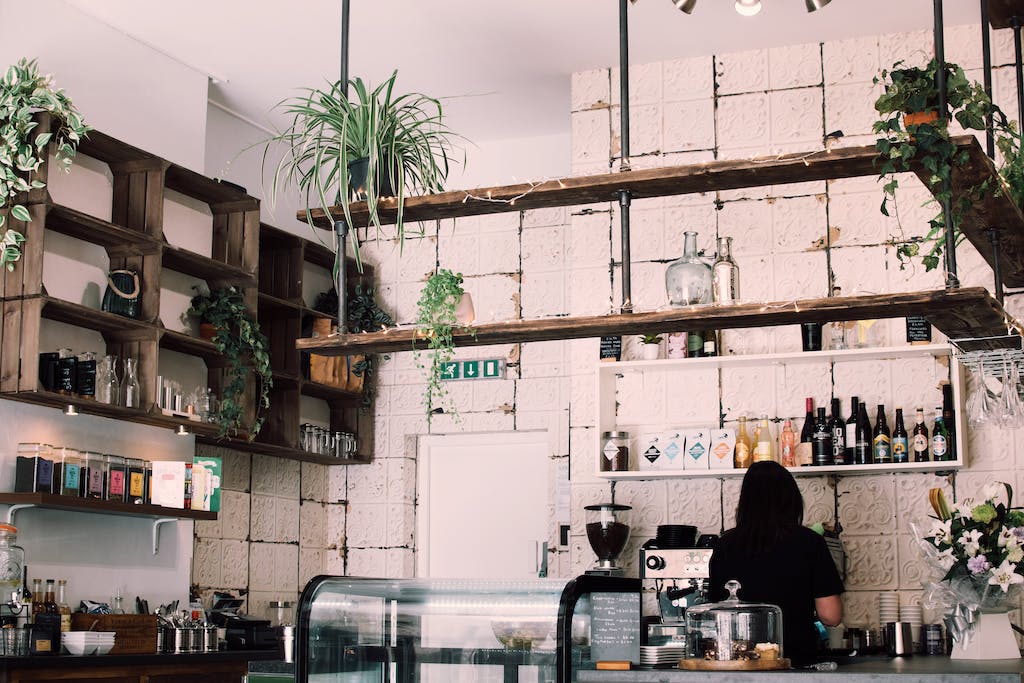
Cafe business plan template
Organizational structure and management.
At the heart of BizCafe’s operations is a meticulously designed organizational structure blended seamlessly with a strategic management approach that nurtures the establishment’s vision of providing premium refreshments in a conducive environment for work and relaxation. Responding to the needs of young professionals and students in New York, BizCafe emerges as a bastion of social interaction and productivity, coupled with the indulgence of gourmet coffees and teas.
The organizational design of BizCafe is anchored in clear-cut roles and responsibilities that promote a collaborative work culture while ensuring efficiency at every managerial and operational level. The leadership team is composed of seasoned professionals with complementary skills and expertise, shaping a cohesive unit that drives forward the company’s objectives.
Alex Taylor, the Co-Founder & CEO, brings a decade of hospitality industry experience and astute business management know-how. Alex’s insight into customer service excellence ensures that BizCafe not only meets but exceeds customer expectations. Jordan Lee, Co-Founder & CFO, with an MBA in finance, navigates the fiscal waters with precision, laying down a robust financial groundwork that underpins the projected growth of the venture.
Directing daily activities is Riley Kim, the Operations Manager, whose operational management prowess and in-depth knowledge of the food and beverage sector ensure that the café operates like a well-tuned engine. With a focus on implementing efficient operational workflows, monitoring inventory, and ensuring staff training is up to par, Riley forms the backbone of BizCafe’s organizational prowess.
Bringing the brand to life is Casey Morgan, the Marketing Director. With a rich background in brand development and digital marketing, Casey is instrumental in carving out BizCafe’s space in a crowded marketplace, pioneering innovative strategies that encapsulate the brand’s ethos and resonate with the target audience.
In confronting industry-specific challenges, BizCafe leverages a proactive risk mitigation framework. To counter fierce competition, the café distinguishes itself with unique branding and customer loyalty programs whilst remaining adaptable, with plans to diversify the menu and refine loyalty rewards should the need arise. Economic downturns are confronted with competitive pricing and keen value deals, backed by strategies to slash operational costs without compromising quality. The threat of supply chain disruption is addressed through multi-faceted supplier relationships and the maintenance of a buffer stock; contingency plans include procuring supplies from local purveyors. Changing consumer preferences are met with a continuously evolving menu informed by customer feedback, with rapid adjustments poised as a standby response to market trends. Regulatory changes are attentively monitored and promptly adhered to, with staff training ensuring compliance.
Projected financial targets are optimistic yet grounded, aiming for a break-even in the first year with subsequent annual growth. Strategic planning anticipates not just the upholding of a strong financial position but also the potential for expansion within the next five years, including the prospect of opening a second location or augmenting service offerings, buttressed by solid profitability and a well-entrenched brand reputation.
Marketing and sales imbue BizCafe with vibrancy, harnessing the power of social media marketing, community engagement, and digital outreach to create and nurture a loyal customer community. Loyalty programs incentivize repeat patronage, and partnerships with nearby businesses amplify the café’s presence and appeal.
In sum, BizCafe stands as a paradigm of a well-structured and astutely managed establishment, blending operational excellence and strategic acumen to deliver an unparalleled café experience and robust business performance. With an eye toward sustainability and another on innovative expansion, BizCafe is well-poised to become an emblematic landmark in New York’s coffee culture landscape.
BizCafe, endeavoring to become the favored haunt for the city's spirited young professionals and scholars, is a burgeoning sensation in the cafe industry. Our establishment seamlessly marries the artistry of specialty coffees and artisan teas with freshly crafted pastries and light meals that answer the call of diverse palates. BizCafe is more than just a retreat for coffee aficionados; it is also a nexus for connectivity, offering high-speed Wi-Fi and ample charging stations, crafted for those who yearn for a comfortable niche to work and study.
Our "Products and Services" section is designed to highlight the values and operational tenets that set BizCafe apart in an industry teeming with competition. We present an inviting atmosphere, friendly to both brisk morning commutes and leisurely afternoons. The sumptuous café offers an expanse where work, study, and informal meetings can unfold in comfort—a rarity in the frenetic pace of New York.
Economic downturns, competition, supply chain disruptions, and changing consumer preferences—the cafe industry is no stranger to these potential risks. To safeguard our venture and flourishing brand against these, we employ strategic forethought. Our robust branding and customer loyalty programs act as our shield against competition, with contingency plans to further diversify our menu and bolster those same loyalty offers if the market demands. We counter economic challenges with competitive pricing strategies complemented by precise operational cost management. We have fostered relationships with a broad network of suppliers and stock contingencies to ensure consistent provisions, with local sourcing as a standby plan against supply chain challenges. We keep our ears to the ground, adapting our menu to reflect market trends and customer feedback, always ready to implement rapid adjustments to meet evolving tastes.
Operational efficiency is the linchpin of our endeavor. With a keen eye on quality and customer satisfaction, we meticulously manage our supplier relationships, staff expertise, inventory, facility maintenance, and regulatory compliance. Our Operations Plan details the measures in place to maintain excellence all-round—from sustainably sourced coffee beans to the engaging customer service delivered by our handpicked team of baristas—all to orchestrate the perfect cafe experience.
BizCafe navigates the marketing arena with as much acumen as it brews espressos. Our Marketing and Sales Strategy is a keen fusion of online dazzle and offline substance. We utilize the sticky webs of social media to captivate our audience, forge loyalty through rewards programs, engage our community through vibrant events, and amplify our reach via collaborations with local businesses.
The coalescence of ambition and management comes into play when we shine a light on the key members of our team. Alex Taylor and Jordan Lee at the helm, their seasoned expertise in business management and financial acumen respectively, ensure that strategic direction and economic stability are a part of the company's bedrock. Bolstered by Riley Kim's operational oversight and Casey Morgan's dynamic marketing campaigns, BizCafe is a testament to exemplary leadership and team synergy.
Financial projections for BizCafe elucidate a narrative of growth and success. We anticipate a breakeven by year-end, which sets the pace for progressive revenue increases in the following years, ideally pivoting towards a significant milestone—potentially reaching a projected revenue of around $1 million by the fourth or fifth year.
Summarily, BizCafe is an enterprise that reverberates with the promise of quality, comfort, and connectivity, grounded firmly on the bedrocks of strategic risk management, operational integrity, and customer-centric growth plans. As we chart our course in New York's dense cafe sector, we remain dedicated to serving not just cups of specialty beverages but also fostering a dynamic hub of activity and relaxation that resonates with the city's beat.

Café business plan
In crafting the Marketing and Sales Strategy for BizCafe, we begin by addressing the fundamental attributes that set BizCafe apart. Our diverse offering of premium specialty coffees, artisan teas, savory pastries, and light meals is crafted to align with the tastes of our target demographic: young professionals and students who desire a blend of quality, convenience, and comfort. With facilities like high-speed Wi-Fi and readily available charging stations, we cater to the productivity and connectivity needs of our customers.
Our marketing framework is designed to communicate these core benefits effectively to our target market. Recognizing the inherent risks in a competitive industry, we've laid out strategies to mitigate these and developed contingency plans. Against competition, we counter with our boutique branding and tailored loyalty programs to foster a strong customer base. Should the competitive landscape intensify, we are prepared to diversify our menu and amplify our loyalty program benefits, further differentiating BizCafe.
In dealing with economic downturns, we focus on positioning our offerings as competitively priced without sacrificing quality. We also streamline operations and collaborate with cost-effective suppliers to maintain healthy margins. For supply chain disruptions, we've cultivated relationships with multiple vendors and maintain buffer stock levels. As an alternative if needed, we have contingencies to source locally.
To keep pace with evolving consumer preferences, we employ ongoing dialogue with our clientele, maintaining flexibility to adapt our offerings swiftly. To ensure readiness for any regulatory changes, we maintain an informed and proactive stance, with training programs to quickly bring staff up to speed on new requirements.
Our approach to market penetration and growth is multi-faceted. We blend organic and paid strategies, including:
- Social Media Marketing : We prioritize engagement on platforms like Instagram and Facebook, where our visual content can shine and resonate with the younger audience. We plan to utilize targeted ads, influencers, and content marketing to bolster our online presence and drive foot traffic.
- Loyalty Programs : We leverage loyalty programs to maintain high customer retention rates, offering rewards that incentivize repeat visits.
- Community Engagement : We understand the value of an integrated community; hence, we host events and workshops aimed at building relationships and encouraging networking within our space. These events range from coffee tastings to productivity workshops, appealing to our demographic of professionals and students.
- Collaborations with Local Businesses and Educational Institutions : Partnering with like-minded businesses and local colleges allows us to extend our reach through cross-promotion while also tapping into existing networks of potential loyal customers.
- Digital Presence and Online Ordering : Given the proclivity of our audience for digital convenience, we maintain a strong digital presence through a user-friendly website and online ordering capabilities for pickups and deliveries.
- Email Marketing : Through carefully curated newsletters, we share updates, promotions, and exclusive offers to maintain engagement with our existing customer base, ensuring that BizCafe remains top-of-mind.
In parallel with these efforts, we recognize the need for a firm foundation. The organizational structure of BizCafe, an LLC, offers flexibility in management with personal liability protection for the owners. Our key management team members, each expert in their field, ensure operations align with strategic goals.
In summary, the Marketing and Sales Strategy for BizCafe is robust, diversified, and perfectly tailored to our target customer's lifestyle. It intertwines BizCafe’s core service offerings with innovative promotional tactics that are set to carve out a significant market share, promising growth, and an irreplaceable spot in our community's daily routine.
BizCafe, nestled within the vibrant streets of New York, is set to reinvigorate the traditional café experience by aligning it with the contemporary lifestyle and preferences of our target market—students and young professionals aged 20-35. Our operations plan is conceived to underpin this dynamic business model by ensuring efficiency, quality, and customer satisfaction.
Our strategic location—a nexus of cultural diversity and a hub for millennial activity—provides BizCafe with the advantage of tapping into a rich customer base yearning for a unique café experience. The provision of high-speed Wi-Fi and charging stations distinguishes us from traditional coffee shops, catering to patrons who seek a conducive place to work or study while indulging in our specialty coffees, artisan teas, and an assortment of pastries and light meals.
Addressing the operational execution, BizCafe will adopt a meticulous approach towards supply management. We shall form strategic alliances with reputable local suppliers to ensure a consistent supply of premium-quality coffee beans, tea leaves, and fresh ingredients for our culinary offerings. These partnerships will enable us to maintain our commitment to quality and sustainability—a fundamental trait of the BizCafe brand.
We recognize that our staff are the ambassadors of our brand. Hence, we will employ skilled baristas and support staff who exhibit a combination of technical expertise in coffee-making and a passion for customer service. A rotating shift system will be implemented to optimize staff utilization across our business hours, ensuring that our service quality does not waver during peak times.
In our quest for excellence, quality control remains paramount. Routine training sessions will be conducted to educate our staff on food safety and the meticulous preparation of our beverages, thereby upholding our promise of consistently high-quality products. We shall leverage advanced inventory management software to monitor stock levels, minimize waste, and streamline the replenishment process.
Realizing the necessity of maintaining an inviting and operational facility, we commit to routine maintenance checks of our café space and the upkeep of our coffee-making equipment. This ensures a pleasurable ambience for our customers and uninterrupted service delivery.
Our financial management, spearheaded by our CFO, will involve regular reviews and proactive budgeting to keep our financial goals on track. This financial foresight, coupled with the implementation of a comprehensive customer feedback system, will enable us to respond adeptly to market demands and elevate our service offerings.
Health and safety compliance is non-negotiable. We pledge to adhere rigorously to local health and safety regulations, conducting regular staff training and audits to foster a safe environment for both our patrons and our team.
BizCafe’s operations plan is not merely a blueprint for daily management but a reflection of our commitment to excellence in providing a compelling café experience. With this at our core, we set forth on a path to build BizCafe into a revered brand synonymous with quality, innovation, and unmatched customer service.

Cafe business plan example
The Financial Projections section provides a forecast that is essential for understanding BizCafe's potential for growth, profitability, and financial stability. This forecast is based on a comprehensive analysis of the current market, comparable business models, consumer behavior, and the broader economic climate. While projections inherently contain assumptions and estimations, they aim to present the most probable outcomes given the business environment and strategies in place.
BizCafe’s financial journey commences with the strategic objective of reaching its break-even point by the end of the first operational year, which aligns with projected revenues of approximately $500,000. Achieving this milestone will signify the successful penetration of BizCafe into the cafe industry and establish a strong foundation for subsequent growth. To facilitate this target, marketing efforts will be ramped up to raise brand awareness and drive traffic to the storefront. Cost management will also remain at the forefront, ensuring expenses are aligned with our growth strategy.
The following years, two and three, are projected to herald a period of steady growth. With established brand recognition and an expanding loyal customer base, we anticipate revenue growth of approximately 20% annually. This growth will be driven by a combination of factors, including an increased adoption of BizCafe's loyalty program, the introduction of new menu items in response to market trends, and strategic marketing campaigns designed to expand our reach. During this period, we anticipate revenues to reach approximately $720,000 by the end of year three, and we project improvement in profit margins due to enhanced operational efficiencies and economies of scale.
Years four and five mark the expansion phase for BizCafe. Fortified by a strong, loyal following and increased cash flows, this chapter will explore new avenues for expansion, which may include the opening of a second location or diversifying service offerings to cater to additional segments, like corporate catering or evening social events. These growth opportunities could further augment revenue, with a possibility of surpassing $1 million by the close of year five.
Throughout this five-year span, BizCafe will remain steadfast in executing our marketing and sales strategies to support these financial goals. Our multi-channel approach, which includes establishing a substantive digital presence, engaging with the community, partnering with local businesses, and consistent brand messaging, will be instrumental in driving sales and increasing profitability.
In preparing these financial projections, we also recognize and plan for potential risks and have formulated mitigation strategies. From the outset, BizCafe will establish a contingency reserve to safeguard against unexpected economic downturns, competitive pressures, or supply chain disruptions, ensuring operational stability and financial resilience.
The projected performance is reliant on the strategic execution by our experienced management team, who will maintain vigilant oversight of financial health. CEO Alex Taylor will lead the charge with a focus on cultivating a high-performing team and elevating the customer experience, while CFO Jordan Lee will enforce rigorous financial controls to safeguard against overspending and cash flow shortfalls.
In summary, BizCafe’s financial projections are rooted in a blend of conservative assumptions and strategic optimism. Our envisioned growth trajectory capitalizes on market opportunities and prudent financial management, positioning BizCafe as a compelling new entrant in the New York cafe sector with robust prospects for enduring success.
Risk management is a critical component for the success of any business, and BizCafe is no exception. Our risk analysis outlines potential challenges that BizCafe may face and establishes mitigation strategies and contingency plans to navigate these risks effectively.
Competition
The café sector in New York is highly competitive, with several key players such as Java Junction, The Study Spot, Green Leaf Tea House, and Urban Grind already established in the marketplace. Each competitor brings strengths to the table: Java Junction's wide variety of coffee blends appeals to busy professionals; The Study Spot attracts students and academics with a quiet atmosphere; Green Leaf Tea House draws in health-conscious clientele with organic offerings; and Urban Grind is favored for its trendy ambiance among young adults.
To mitigate this risk, BizCafe’s strategy hinges on unique branding and building a strong customer loyalty program that incentivizes repeat visits. Our contingency plan includes diversifying our menu options and enhancing loyalty programs to retain customers and attract new ones, even in a saturated market.
Economic Downturns
Providing luxury discretionary products such as specialty coffee, economic downturns could pose a significant risk to BizCafe’s profitability. Customers may cut back on non-essential spending during these periods.
Mitigation for this risk involves offering competitive pricing and creating value deals that are attractive to customers looking for affordable luxury. Our contingency includes reducing operational costs, such as renegotiating leases or finding cost-effective suppliers without compromising the quality of our products.
Supply Chain Disruption
Supply chain volatility can affect the availability of critical inputs like coffee beans, specialty teas, and baked goods. This risk could be caused by global events, natural disasters, or other unforeseen disruptions.
To counteract this, BizCafe will establish relationships with multiple suppliers and maintain a buffer stock to safeguard against short-term disruptions. The contingency plan focuses on developing local sourcing alternatives to reduce dependency on distant supply chains.
Changing Consumer Preferences
Consumer tastes in the food and beverage industry are constantly evolving. Failure to adapt to these changes can result in loss of market share.
Our approach includes staying abreast of industry trends and customer feedback to adapt our menu accordingly. As a contingency measure, BizCafe is prepared for rapid menu adjustments and the roll-out of new products, keeping our offerings fresh and aligned with customer preferences.
Regulatory Changes
Operating in the food and beverage industry, BizCafe must comply with numerous regulations concerning health and safety, labor laws, and food standards. Regulatory changes could impose additional costs or require operational adjustments.
Our mitigation strategy involves staying informed of regulatory changes and ensuring full compliance. Should significant regulatory changes be implemented, our contingency plan includes swiftly revising operational practices and investing in staff training to meet new requirements.
Financial Management
BizCafe’s financial health is paramount to its success. Poor financial management could lead to cost overruns, inadequate cash flow, and ultimately, business failure.
To mitigate this risk, regular financial reviews and strict budgeting practices will be instituted, overseen by our experienced CFO, Jordan Lee. Our risk-averse financial strategy involves conservative projections with room for agile adjustments to the market’s ebbs and flows.
In conclusion, BizCafe's risk analysis is comprehensive, taking into account a multitude of factors that could influence the café's success. By employing proactive mitigation strategies and having robust contingency plans, BizCafe is poised to address these risks effectively while remaining focused on delivering exceptional service to our target market.

Coffee shop business plan
More business plan templates.
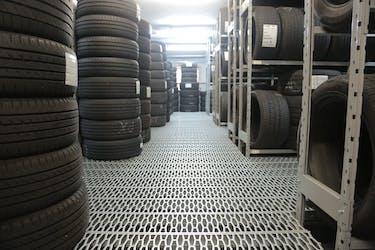
Tire shop business plan

Sandwich shop business plan

Laundromat business plan
Cafe Business Plan Template
Written by Dave Lavinsky
Cafe Business Plan
You’ve come to the right place to create your Cafe business plan.
We have helped over 1,000 entrepreneurs and business owners create business plans and many have used them to start or grow their Cafes.
Below is a template to help you create each section of your Cafe business plan.
Executive Summary
Business overview.
The Countryside Cafe is a startup cafe founded by Cheryl Nelson and Tammy Overton in Tulsa, Oklahoma. Together they have over twenty years of experience in managing and operating cafes and they are highly skilled in the creation of menu items customers love, exemplary service to customers, and in their honed expertise in running efficient and profitable restaurants. Cheryl is the former manager of a family-owned restaurant, where she had oversight of the employees, ordering, systems and financial record-keeping for the restaurant. Tammy was the head staff person of a chain restaurant who managed the scheduling, training and day-to-day operations of the restaurant. Together, they have decided to bring a family friendly environment and classic menu items to Tulsa.
Product Offering
The following are the products and services that Countryside Cafe will provide:
- Exemplary service for customers
- Honest, reliable relationships with vendors and suppliers
- Restaurant services 24/7 hours to accommodate all residents of the area
- Discounted menu pricing and expedited service for first responders
- Family-friendly menu items that everyone can enjoy
- Day to day management
Customer Focus
The Countryside Cafe will target customers throughout the Tulsa region who enjoy eating comfort foods, such as they may have grown up eating. Secondary target customers will be those who enjoy the hometown-feel of a small cafe rather than a large or more modern establishment. Those individuals who occupy nearby businesses or government offices will also be targeted by the Countryside Cafe, as well as those who own farms or ranches in the region.
Management Team
The Countryside Cafe will be owned by Cheryl Nelson and Tammy Overton. Together they have over 20 years of experience in managing and operating a regional cafe and they are highly skilled in the creation of menu items customers love, exemplary service to customers, and in their honed expertise in running efficient and profitable organizations. Cheryl is the former manager of a family-owned restaurant and Tammy was the head staff person of a chain restaurant. Together, they have decided to bring a family friendly environment and homestyle, fresh foods to Tulsa. The menu will include breakfast, lunch and dinner meals, as well as popular favorites such as ice cream sundaes and homemade pies any time of day.
Success Factors
Countryside Cafe will be able to achieve success by offering the following competitive advantages:
- Friendly, knowledgeable, and highly-qualified team of Countryside Cafe
- Comprehensive menu of meals for any time of day, including snacks, such as French fries and desserts, along with soda fountain favorites such as sundaes, malts and milkshakes.
- Countryside Cafe will offer special discounted pricing for first-responders in Tulsa.
- Countryside Cafe will offer a child menu and a play area for children while their parents enjoy their meal.
- First-time visitors to the Countryside Cafe will receive a free dessert of their choice.
- Countryside Cafe offers the best pricing in town. Their pricing structure is the most cost effective compared to the competition.
Financial Highlights
Countryside Cafe is seeking $200,000 in debt financing to launch its cafe business. The funding will be dedicated toward securing the restaurant space and purchasing office equipment and supplies. Funding will also be dedicated toward three months of overhead costs to include payroll of the staff, rent, and marketing costs for the print ads and marketing costs. The breakout of the funding is below:
- Restaurant space build-out: $20,000
- Office equipment, supplies, and materials: $10,000
- Three months of overhead expenses (payroll, rent, utilities): $150,000
- Marketing costs: $10,000
- Working capital: $10,000
The following graph outlines the financial projections for Countryside Cafe.
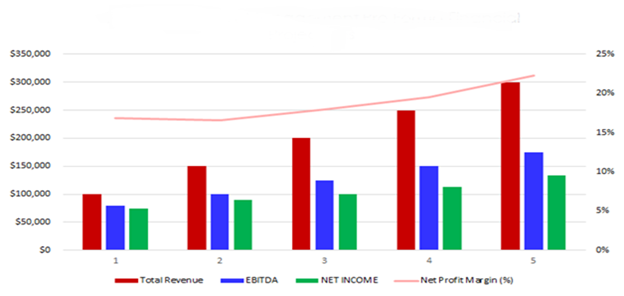
Company Overview
Who is countryside cafe.
Countryside Cafe is a newly established, full-service homestyle cafe in Tulsa, Oklahoma. Countryside Cafe will be the most reliable, cost-effective, and efficient choice for individuals and families, as well as businesspeople in Tulsa and the surrounding communities. Countryside Cafe will provide a comprehensive menu of favorite meals, snacks and desserts for any diner to utilize. Their full-service approach includes a comprehensive menu and seating options to suit each family, including small children.
Countryside Cafe will be able to serve over fifty people at one time. The team of owners and staff members are highly qualified and experienced in preparing, making and serving favorite family meals and snacks. Countryside Cafe removes all headaches and issues of finding easy, friendly and moderately-priced meals in Tulsa and ensures all appetites are satisfied while delivering the best customer service.
Countryside Cafe Management History
The Countryside Cafe consists of two experienced restaurateurs with distinctive areas of expertise: Cheryl Nelson and Tammy Overton have over twenty years of experience together in managing and operating a regional cafe and they are highly skilled in the creation of menu items customers love, exemplary service to customers, and in their honed expertise in running efficient and profitable organizations.
Cheryl Nelson is the former manager of a family-owned restaurant, where she had oversight of the employees, ordering, systems and financial record-keeping for the restaurant. Tammy was the head staff person of a chain restaurant who managed the scheduling, training and day-to-day operations of the restaurant. Together, they have decided to bring a family friendly environment and honest, favorite foods to Tulsa.
Since incorporation, Countryside Cafe has achieved the following milestones:
- Registered Countryside Cafe, LLC to transact business in the state of Oklahoma.
- Have a contract in place for a 20,000 square foot restaurant space in a family-friendly retail area
- Reached out to numerous contacts to visit the Countryside Cafe upon launch and regularly after the launch.
- Began recruiting a staff of eight servers and four office personnel to work at the Countryside Cafe.
Countryside Cafe Services
The following will be the services Countryside Cafe will provide:
Industry Analysis
The cafe and small restaurant industry is expected to grow over the next five years to almost $500 million. The growth will be driven by consumers who seek favorite foods they’ve always enjoyed. Consumers also want to be served in small, more intimate settings which are relaxing and comfortable. Customers with children will help grow the cafe industry because, as families, they are more relaxed in the informal “down home” comfort of a small cafe versus a large, more formal restaurant.
Costs will likely be reduced as cafes continue to expand and modify their menus to seek out the best, most desirable menu items for consumers rather than spending widely on menu choices that may not be well-received. Costs will also continue to go down due to lower prices on produce and beef within the Oklahoma area. As fresh fruit is more in demand, juices and smoothies will cost less to produce than in the past, as well.
Customer Analysis
Demographic profile of target market, customer segmentation.
Countryside Cafe will primarily target the following customer profiles:
- Individuals and families within the region
- Small business owners and employees within the region
- City officials and those who work in the business of Tulsa
- Farmers and ranchers in the greater Tulsa regions
Competitive Analysis
Direct and indirect competitors.
Countryside Cafe will face competition from other companies with similar business profiles. A description of each competitor company is below.
Mama’s Kitchen
Mama’s Kitchen was started in 1998 by Candy and Jamie Swanson. Originally intended as a truck stop, Mama’s Kitchen grew to include a larger restaurant area in 2005 and has served breakfast and lunch to travelers from that time to the present. Located on the main highway through the city of Tulsa, the restaurant receives many travelers who opt to stop for a meal.
Mama’s Kitchen is twenty-three miles away from the Countryside Cafe. There are a few similarities to the menus served by both restaurants, as homestyle fare is offered. The differences between the two restaurant businesses is found in the family-friendly dining-booth atmosphere of the Countryside Cafe, while Mama’s Kitchen has countertops and bar stools throughout. This makes seating for a family difficult and children are not able to reach the countertops on stools at Mama’s Kitchen, which creates discomfort for children.
Buddy’s Bar & Grill
Owned by Robert “Buddy” Gorman, Buddy’s Bar & Grill is a full-service bar with a small dining room attached. The restaurant is located six miles from the Countryside Cafe. Meals are served at Buddy’s Bar & Grill during lunch and dinner; however, the restaurant is not open for breakfast. Meals are geared toward grilled hamburgers, steaks and fried fish, while the bar menu is laden with appetizer choices served during happy hour each Tuesday afternoon. Robert Gorman is assisted by his sister, Babs, who acts as the lone server in the grill and is known for her fast service and quick wit, which customers find charming. Children are not allowed in the bar, but they can be served in the grill side of the restaurant. The children’s menu is limited to hamburgers or cheese sandwiches served with fries.
Howard’s Family Restaurant
Howard’s Family Restaurant serves breakfast, lunch and dinner in a small dining room attached to the golf country club on the outskirts of Tulsa. It is located ten miles from the Countryside Cafe. Most patrons of Howard’s Family Restaurant are golfers who want to enjoy a meal before or after playing golf. The restaurant is one of a chain of restaurants and, while the prices are higher than those of the other cafes and small restaurants in Tulsa, the restaurant is known by the national marketing of the parent company. Children are served a special kids’ play and dine menu and families are highlighted as the primary target of the chain.
Competitive Advantage
Countryside Cafe will be able to offer the following advantages over their competition:
- Friendly, knowledgeable, and highly-qualified team of the Countryside Cafe.
Marketing Plan
Brand & value proposition.
Countryside Cafe will offer the unique value proposition to its clientele:
- Highly-qualified team of skilled employees who are able to provide a delicious meal in a pleasant surrounding for the entire family.
- Countryside Cafe will offer special discounted pricing for first-responders in Tulsa, including police, fire and hospital staff. Doctors and nurses are also included.
- First-time visitors to the Countryside Cafe will receive a free dessert of their choice, which helps guests feel welcome and comfortable.
- Unbeatable pricing to its clients; they will offer the lowest pricing in the city.
Promotions Strategy
The promotions strategy for Countryside Cafe is as follows:
Word of Mouth/Referrals
Countryside Cafe has built up an extensive list of contacts over the years by providing exceptional service and expertise to their clients, including guests of all ages. The personal contacts and business associates will follow the new owners to the new cafe and help spread the word of Countryside Cafe.
Professional Associations and Networking
The new owners of the Countryside Cafe, Cheryl and Tammy, will join the civic organizations and trade networks to help build their cafe to its potential. They will become active in the committees for city celebrations, as well, to help build visibility of their cafe and raise awareness of their specialty menu items.
Print Advertising
The Countryside Cafe will send a direct mail flyer to each home and business in Tulsa in the two weeks prior to the launch of the restaurant. The flyer will invite everyone to participate in special discounted offers during the first month of business and offer a free dessert for each person who stops by to check out the area’s newest cafe.
Countryside Cafe will fully utilize their website. The website will be well organized, informative, and list all the services that Countryside Cafe provides. The website will also list their contact information and list their menu and pricing, along with delivery options. The website will engage in SEO marketing tactics so that anytime someone types in the Google or Bing search engine “homestyle cafe” or “cafe near me,” Countryside Cafe will be listed at the top of the search results.
The pricing of Countryside Cafe will be moderate and below or on par with competitors so customers feel they receive excellent value when purchasing their products and services. Certain items, such as the childrens’ menu items, will be priced at a reduced profit margin in order to facilitate larger families that want to visit and can afford to do so with the reduced prices.
Operations Plan
The following will be the operations plan for Countryside Cafe. Operation Functions:
- Cheryl Nelson will be the co-owner and president of the company. She will oversee all business development and manage client relations.
- Tammy Overton will be the co-owner and vice president of the company. She will manage the operations and oversee all staff members.
- Tyler Grant will be the Office Manager who will manage the office administration, client files, and accounts payable.
- Tommy Tucker will be the maintenance employee who will provide all maintenance and repairs at the property.
Milestones:
Countryside Cafe will have the following milestones completed in the next six months.
- 5/1/202X – Finalize contract to lease restaurant space
- 5/15/202X – Finalize personnel and staff employment contracts for the Countryside Cafe
- 6/1/202X – Finalize contracts for Countryside Cafe vendors and wholesale accounts
- 6/15/202X – Begin networking at industry events
- 6/22/202X – Begin moving into Countryside Cafe restaurant
- 7/1/202X – Countryside Cafe opens its doors for business
The Countryside Cafe will be owned by Cheryl Nelson and Tammy Overton. Together they have over twenty years of experience in managing and operating a regional cafe and they are highly skilled in the creation of menu items customers love, exemplary service to customers, and in their honed expertise in running efficient and profitable organizations.
Cheryl Nelson is the former manager of a family-owned restaurant and Tammy was the head staff person of a chain restaurant.Together, they have decided to bring a family friendly environment and homestyle, fresh foods to Tulsa. The menu will include breakfast, lunch and dinner meals, as well as popular favorites such as ice cream sundaes and homemade pies any time of day.
Financial Plan
Key revenue & costs.
The revenue drivers for Countryside Cafe are the fees they will charge to customers for their products and services.
The cost drivers will be the overhead costs required in order to staff Countryside Cafe. The expenses will be the payroll cost, rent, utilities, inventory, office supplies, and marketing materials.
Key Assumptions
The following outlines the key assumptions required in order to achieve the revenue and cost numbers in the financials and in order to pay off the startup business loan.
- Number of restaurant customers per Month: 1,000
- Average revenue per Month: $25,000
- Office Lease per Year: $100,000
Financial Projections
Income statement, balance sheet, cash flow statement, cafe business plan faqs, what is a cafe business plan.
A cafe business plan is a plan to start and/or grow your cafe business. Among other things, it outlines your business concept, identifies your target customers, presents your marketing plan and details your financial projections.
You can easily complete your Cafe business plan using our Cafe Business Plan Template here .
What are the Main Types of Cafe?
There are a number of different kinds of cafe businesses , some examples include: Take-Out Cafe, Restaurant Cafe, Casual cafe, and Coffee Shop.
How Do You Get Funding for Your Cafe Business Plan?
Cafe businesses are often funded through small business loans. Personal savings, credit card financing and angel investors are also popular forms of funding.
What are the Steps To Start a Cafe Business?
Starting a cafe business can be an exciting endeavor. Having a clear roadmap of the steps to start a business will help you stay focused on your goals and get started faster.
- Develop A Cafe Business Plan - The first step in starting a business is to create a detailed cafe business plan that outlines all aspects of the venture. This should include potential market size and target customers, the services or products you will offer, pricing strategies and a detailed financial forecast.
- Choose Your Legal Structure - It's important to select an appropriate legal entity for your cafe business. This could be a limited liability company (LLC), corporation, partnership, or sole proprietorship. Each type has its own benefits and drawbacks so it’s important to do research and choose wisely so that your cafe business is in compliance with local laws.
- Register Your Cafe Business - Once you have chosen a legal structure, the next step is to register your cafe business with the government or state where you’re operating from. This includes obtaining licenses and permits as required by federal, state, and local laws.
- Identify Financing Options - It’s likely that you’ll need some capital to start your cafe business, so take some time to identify what financing options are available such as bank loans, investor funding, grants, or crowdfunding platforms.
- Choose a Location - Whether you plan on operating out of a physical location or not, you should always have an idea of where you’ll be based should it become necessary in the future as well as what kind of space would be suitable for your operations.
- Hire Employees - There are several ways to find qualified employees including job boards like LinkedIn or Indeed as well as hiring agencies if needed – depending on what type of employees you need it might also be more effective to reach out directly through networking events.
- Acquire Necessary Cafe Equipment & Supplies - In order to start your cafe business, you'll need to purchase all of the necessary equipment and supplies to run a successful operation.
- Market & Promote Your Business - Once you have all the necessary pieces in place, it’s time to start promoting and marketing your cafe business. This includes creating a website, utilizing social media platforms like Facebook or Twitter, and having an effective Search Engine Optimization (SEO) strategy. You should also consider traditional marketing techniques such as radio or print advertising.
Learn more about how to start a successful cafe business:
- How to Start a Cafe

Cafe Business Plan
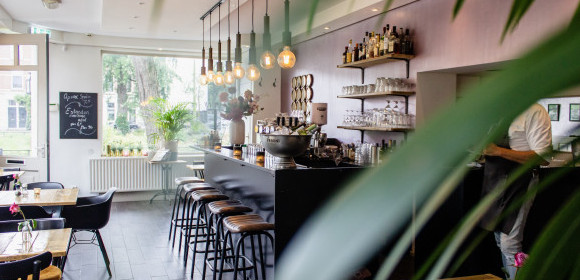
Coffee ranks second in the most sought commodities worldwide, the first is crude oil, according to a Business Insider report. That doesn’t come as a surprise. We’re all aware that most of us love drinking coffee. For some, coffee is their morning kick-starter and their fuel to start their long, busy day. Others drink several cups of coffee throughout their daily schedule , especially those who have desk jobs. But simply put, people are fond of coffee in general, which could also mean they’re fond of visiting cafes. So if you’ve been considering opening a cafe business lately, now is the time to go for it. It’ll certainly catch the attention of coffee lovers. But first, you need to plan your business right for that to happen. So, here we invite you to have a look at our Cafe Business Plan Examples !
11+ Cafe Business Plan Examples
1. cafe business plan financial template.
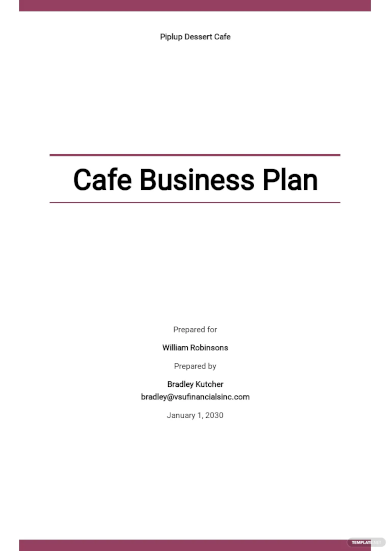
- Google Docs
- Apple Pages
Size: 25 KB
2. Cafe Business Plan Template
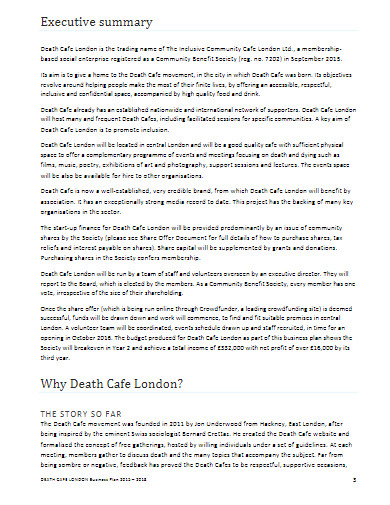
3. Cafeteria Business Plan
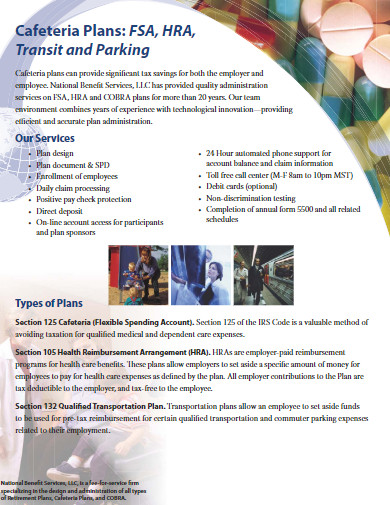
Size: 550 KB
4. Cafe Business Plan Example
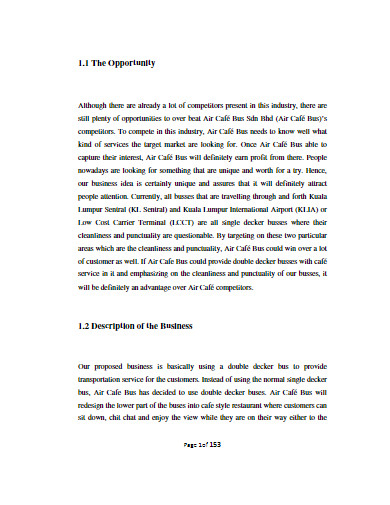
5. Start-up Cafe Business Plan
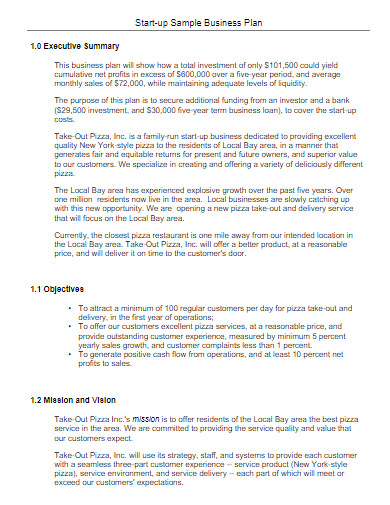
Size: 195 KB
6. Sample Cafe Business Plan
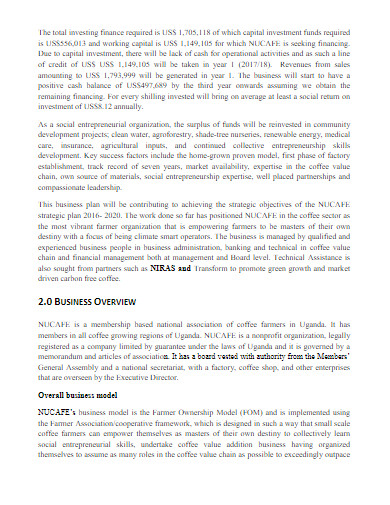
7. New Cafe Business Plan

8. Cafeteria Business Plan Template
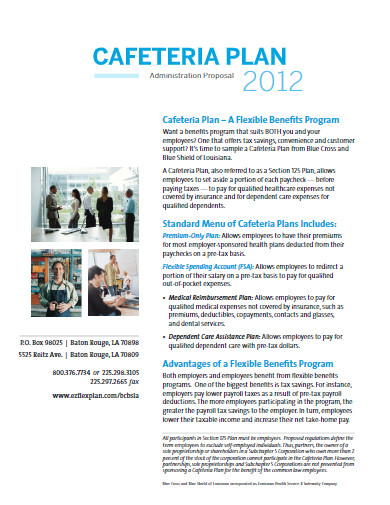
9. Cafe Business Plan in PDF
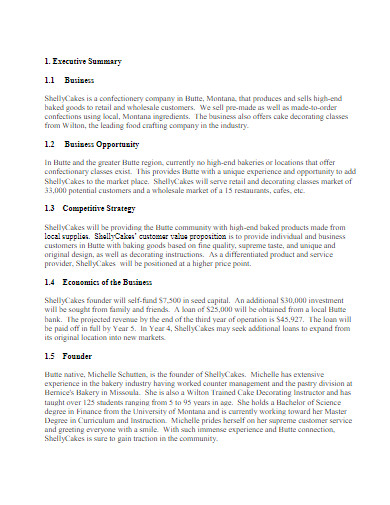
10. Outdoor Cafe Business Plan
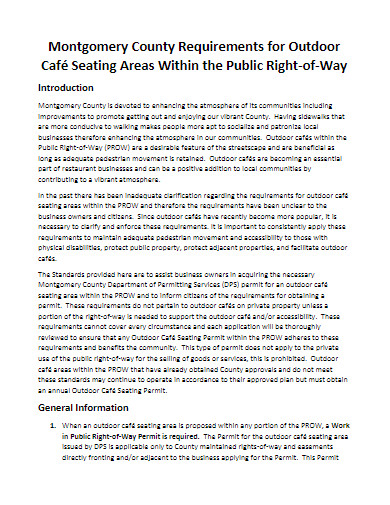
11. College Cafe Business Plan

12. Cafe Marketing Business Plan
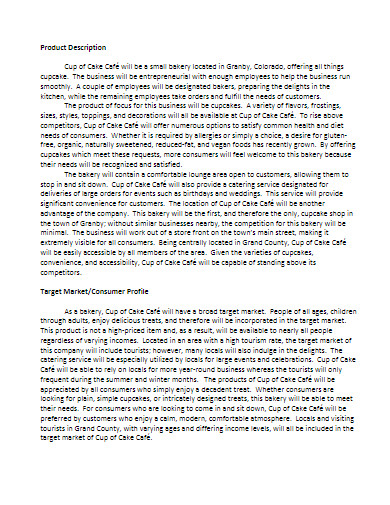
Size: 212 KB
What Is a Cafe Business Plan?
A cafe business plan outlines the profile, products, services, operations, and strategies of a cafe business. It’s simply another form of a business plan that focuses on a cafe business’s overview. You can also call it a coffee shop business plan . This is the document you need to prepare to start making your cafe plan a reality. You should put everything that you’re envisioning for your cafe business on it.
You might be asking why you need a cafe business plan. We have a good explanation for you. Without a business plan, you wouldn’t have a clear vision or goal of establishing your cafe. And you won’t have any form of a solid action plan to achieve your business expectations. Along the way, you’ll face challenges in preparing your business. But you won’t know what to do to overcome them. With a written business plan , you’ll have a clear roadmap of how to arrive from point A to B and so on until you accomplish your business goals. And lastly, the government will look into your cafe business plan proposal before granting you a permit to open your cafe.
What Type of Business Is a Cafe?
Cafes primarily serve coffee to their customers. Therefore, they’re a food and beverage type of business. Historically, cafes were once called as coffeehouses, and they only served coffee. Today, cafes not only serve coffee. They now also serve entree, main course, and dessert dishes, but on a limited menu . Their primary products are still their coffee menu and also tea menu .
How to Write a Cafe Business Plan
Among the first steps in conceptualizing a business is writing a business plan. It’s the first stage in your journey to becoming a cafe business owner. So to help you get started, we’ll give you a few tips in formulating your sample business plan for a cafe.
1. Establish Your Cafe’s Identity
In the first three sections of your business plan, you should establish your cafe’s identity right away. On the title page, you should state your cafe’s official name and display its business logo . On the executive summary , discuss its general overview. And after that, show its business profile.
2. Showcase Your Menu
If you’ve already prepared your cafe menu , showcase it in your business plan. This makes your business plan more appealing and convincing. It implies that you have a clear idea of what you want for your business, even if it’s not final yet. Make sure to provide descriptions of your products, such as their ingredients and possible prices.
3. Outline Your Strategies and Standard Operations
In launching a business, you’ll be doing a feasibility study and a market analysis . Based on their results, you need to come up with your marketing strategies and production plan . Those two should explain how you’re going to promote your cafe and how you’re going to conduct services, respectively.
4. Explain Your Startup Budget Calculation
Probably the most crucial section of a business plan is the budget plan . Financial aspects are never out of the equation in operating a business, especially starting one. So in your business plan, make sure to explain how your budget will cover for every needed expense for your cafe. You should also show an estimate of how it can generate revenue and profit.
What industry does a cafe business belong to?
A cafe business belongs to the food and beverage industry. But because it primarily serves coffee products, it also belongs to a specific section in the food and beverage industry, which is the coffee industry.
What makes cafes popular?
Coffee isn’t the only element that makes cafes popular in every locality. Another element is their overall ambiance. That includes the type of furniture used, the interior design, and the location. The atmosphere that cafes have are simply relaxing. They’re a good place to do work, meet up with friends, read a book, or spend some alone time.
What makes a topnotch cafe business?
The two things that make a topnotch cafe is producing high-quality coffee products and providing excellent customer service. Those two should work hand in hand.
Things could go south immediately if you mismanage your cafe. Plus, many cafes have established trust among customers, and they’re your competitors. With those said, running your cafe won’t be easy. But whoever said owning a business is easy? No one, of course. So start planning your cafe with the help of our business plan examples now! You may also refer to our small restaurant business plan examples .
Text prompt
- Instructive
- Professional
Create a study plan for final exams in high school
Develop a project timeline for a middle school science fair.

How to Open a Café Business
How to Open a Café Business – Ultimate Beginner's Guide PDF

Successfully Opening a Café Business
Opening a café business can be an exciting opportunity for aspiring entrepreneurs. The sound of steaming espresso machines, delicious food being served, and the lively chattering of customers can pique the interest of any new business owner.
A café is one of many different coffee shop concepts that could work in your community. Finding the right concept for the right location to serve the appropriate target market will be a significant part of your café planning.
In today's post, we'll deep dive into the steps you'll want to take to open a café successfully.
How much does a café business cost?

Several main factors impact the cost of a café, which requires two specific budget breakdowns .
The first budget would be your café startup budget . The second cost breakdown would be your operational budget .
Your coffee shop startup budget will be the money you need to get from Square One to your grand opening. This budget includes your research, planning, legal, and administrative costs. Additionally, your startup budget includes your initial space lease, café buildout, equipment costs, furniture and fixtures, and training.
Your operational costs are centered on the day-to-day or monthly cost of operating your café. This includes your lease, insurance, labor, inventory, taxes, and other expenses.
Since a café often has a more extensive menu and offers indoor seating, the costs of a traditional café are often higher than that of a conventional coffee shop.
These costs will fluctuate depending on the location, size of the kitchen, menu offerings, real-estate, and buildout costs.
For more information, read our post, How Much Does it Cost to Start a Coffee Shop?

Beginner's Guide
Opening a Café Business (Easy Steps)
- pick a cafe concept
- choose a cafe menu
- determine what will make you stand out
- define your branding
- determine your cafe budget
- understand who your cafe customers will be
- setup your business structure
- choose your cafe location
- pick your cafe equipment
- write a cafe business plan
- determine your cafe funding
- choose your cafe roaster
- build out your cafe
- get a cafe license and permits
- develop a coffee brand and marketing strategy
- hire amazing baristas
- always deliver excellence
Trending Articles on Coffee Shop Startups:
Steps open a café business, pick a café concept..
Cafés come in all shapes, sizes, and themes. Even café concepts can vary among other cafés.
What type of café do you wish to have? Perhaps, more clearly, what kind of experience would you want your café customers to have?
Choosing the right café concept to fit your customers in a specific location will be vital to driving sales and keeping your business humming strong.
You will want to settle on a specific niche in the marketplace that offers a unique experience and a different menu. This will help side-step competitors and appeal to customers.
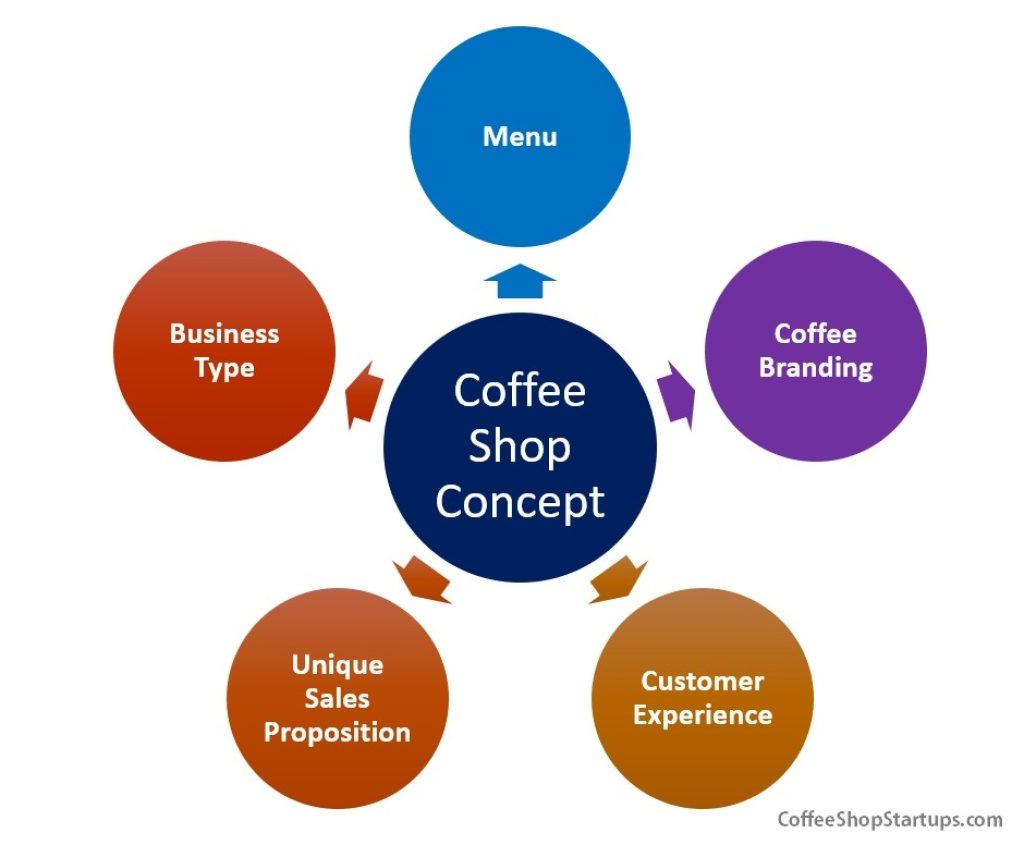
Choose your café menu.
Cafés are often more than just traditional coffee shops and differ in various ways. For example, cafes often have a more extensive menu than traditional drive-thru coffee stands or coffee shops. Some cafes even can have a full kitchen, a large bakery operation, and a coffee roastery. Of course, many cafes also serve alcohol as well. Serving alcohol at your café may require additional permits and licenses, so check with your state's alcohol board.
These are significant undertakings, cost additional money, and require a greater startup budget and operational budget to maintain. But, of course, the benefits of having these operations in-house can improve your sales and increase your profit margin.
Choosing your café menu will play a big part in other big decisions you'll be making. Everything from your space needs, permit requirements, employee wages, and cafe equipment needs will be determined by your café's menu.
Deciding on your menu requires you to grasp what your customers want at the price they are willing to pay.
Determine what's going to make you stand out
Now that you are honing in on a concept and menu, this might be an excellent time to determine how your café will stand out from the competition.
The “special thing” that makes you different will often give you a competitive advantage in the marketplace and separate you from the rest of the choices available.
Perhaps it will be your special soup your rotating business lunches, or your in-house roasted organic coffee. It could be your decadent pastries or special cakes made by your award-winning baker. It might be the collection of art on your walls, your panoramic view, or the music you offer every night. All these elements and more have the potential to be a unique feature that only your café offers.
We often refer to this particular thing as your Unique Sales Proposition or USP.
Coming up with a winning USP will better position you among competitors and provide you with a solid foothold to make other decisions. This will include your branding, messaging, and marketing efforts. It will also help improve your sales and training and give you a competitive edge.
Define your cafe branding.
As you begin to outline what type of café you will be in, you will also want to develop your café brand and messaging behind it.
Your café branding will include, among other things, your logo, name of business, your use of colors, menu choices, uniforms, etc.
Your branding may be reinforced by your décor, design, and layout, among other things.
Additionally, your messaging – the use of language, slogans, and energy that you communicate via all of your channels (website, social media, signage) – plays a role in what type of café you have chosen.
Your messaging has to appeal and trigger action among your target market to maximize your success and drive sales. So, as you move forward with your business planning, start crafting and refining your logo and overall messaging. If you need help, there are affordable branding experts online who can help design your logo, signs, and other items.
Yet, there are plenty of things you can do yourself before hiring an expert, so keep reading!
Determine your cafe budget.
In the early stages of your planning, you will want to sketch out your café startup budget . Of course, the easiest way is to start listing the things you need to get your café up and running.
Your cafe budget will be central to answering the question: How much will your café cost?
This final estimate and budget will take a little planning, realistic estimates, and adjusting.
As you plan out your café business, your budget may naturally increase. Keep a running list and include this budgeting effort in your cafe business plan .
You will also need to create an operational budget. This operational budget will itemize the costs of being open and running your café daily. These two estimated budgets (your startup budget and operational budget) will be essential to understand before you launch your business.
My recommendation is that you don't create and act on your budget in “real-time” or as you go. Instead, determine your café budget first – analyze it against your business plan, then move forward with securing the funds needed to get your café operational – and then spend the money.
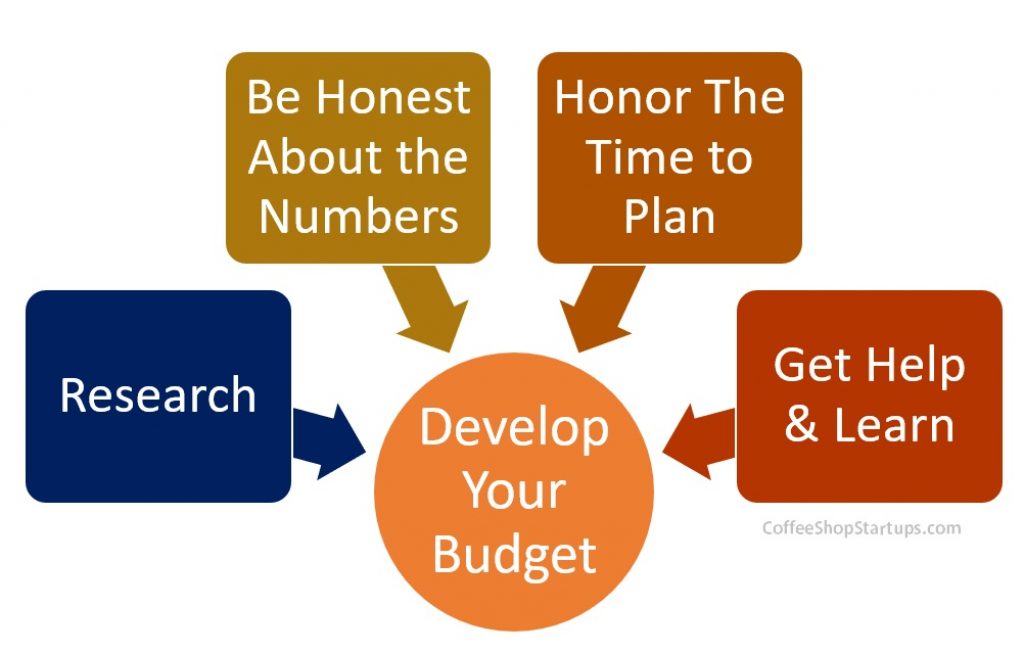
Opening a café business
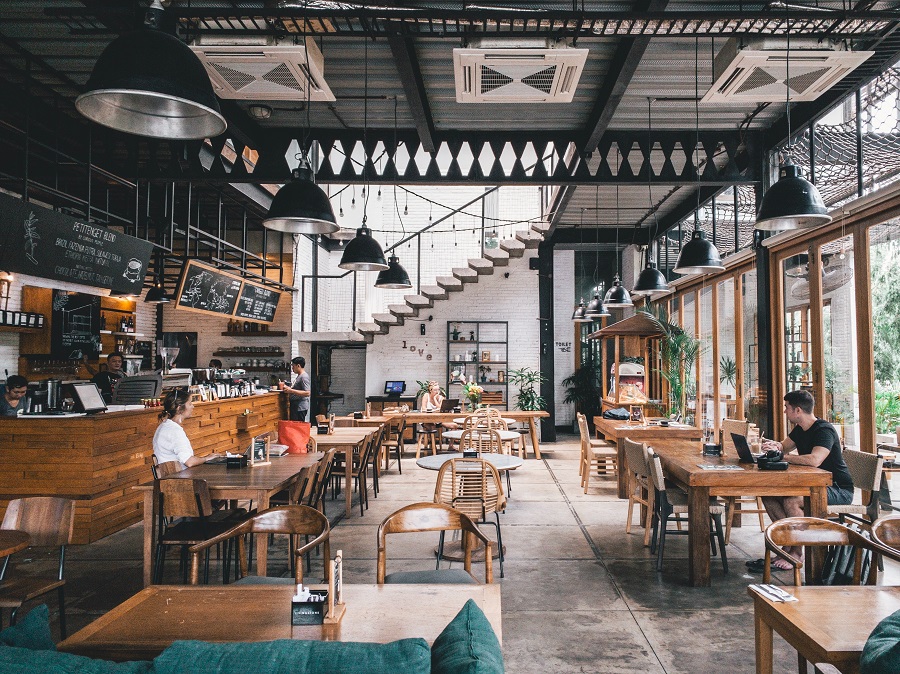
Understand who your café customers will be.
There is no secret that your customers play a significant role in your café's success. From generating sales and repeat business to being your most prominent marketers – your customers are the foundation of your profit and continued success.
Start with determining who your customers are. It should be among the first necessary steps you'll need to take. Afterward, you can start molding your entire business to serve them.
Your target market is the general market to which your café will appeal, often based on your geographic convenience, accessibility, and business concept.
If you dig a little deeper – you will also know who your target customers are – or those customers that are most likely willing to buy from you.
Set up your business structure.
To operate your café legally, you will have to set up an appropriate business structure. Often, your business structure is created in the state in which you plan on operating your business. This is done through your specific state's secretary of state office.
Keep in mind that you can still operate your business in other states and regions as long as you have the appropriate business licenses and health permits and complete other requirements for those areas. For example, you might decide to open a coffee business in New York but decide to operate a second coffee shop located in Los Angeles .
Your business structure is an essential part of your café startup process. You'll have several business structures to choose from – such as a sole proprietorship, corporation, limited liability company (LLC) , etc.
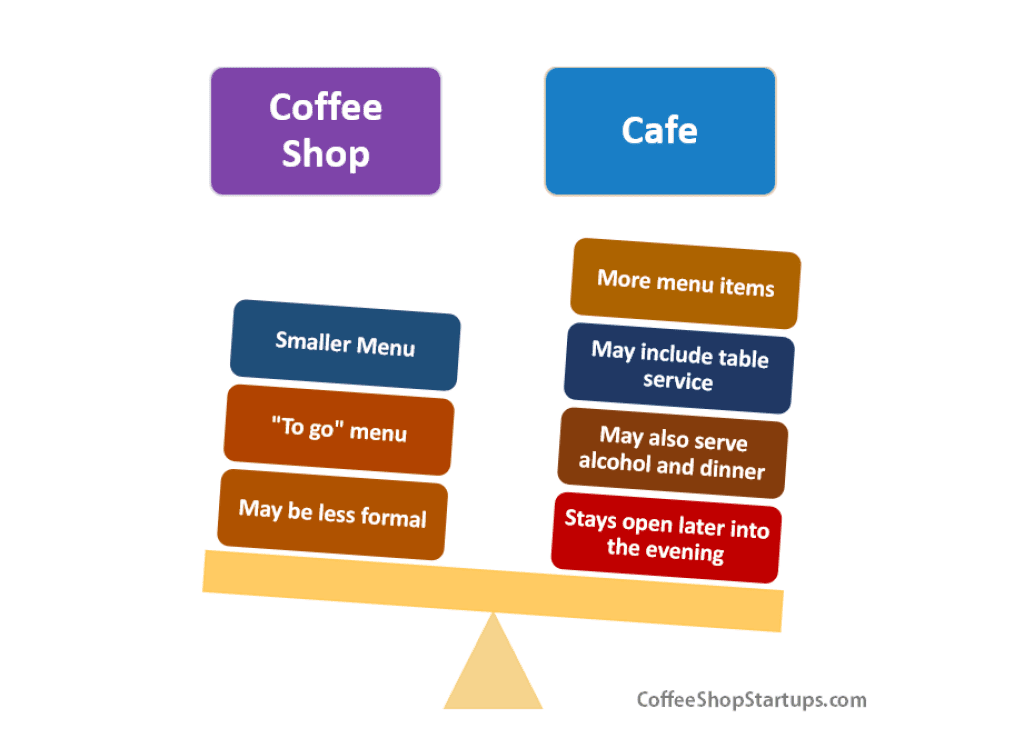
Choose your cafe location.
Choosing the best location for your café will be the cornerstone of your success. The perfect location can determine your sales strengths and position you to maximize exposure.
There are a few essential elements that revolve around your café's location. Your location should be easily accessible to your target market, and have parking and lighting, among others.
You will have to factor in neighboring businesses, competition, and other essential elements in your prospective location. These include neighboring points of interest, parks, farmers' markets, theaters, etc.
Additionally, your location's lease will be critical in moving forward with the location. A poor lease or a lease that makes business difficult may hamper your progress and sales.
For more information, read our post, How to Choose the Best Location for Your Café .
Pick your cafe equipment.
Now that you've picked out the concept and your menu and you're settling on a location, you'll want to start choosing the café equipment pieces you'll need.
Detail items such as ovens, stoves, and refrigerators. You will also need an espresso machine, commercial coffee grinders, and brewing devices.
Your café equipment will be a significant part of your budget and requires some thoughtful budgeting and comparison shopping. You may also want to include your café displays, menu boards, furniture, and fixtures in your calculations here as well.
For more information on choosing your coffee shop, please read The Coffee Shop Equipment You Need
Write a café business plan
Writing a café business plan will help get all your thoughts, ideas, and plans on paper. In addition, your business plan will play a key role in helping you organize your thoughts and ensure that all elements of your business are addressed.
A café business plan is written for a small and significant audience. First, your business plan will be read by your potential investors, partners, and bank lenders. Next, your café business plan will also be read by property managers. Most property managers will expect to see a business plan which allows them to understand the nature of your business and operations thoroughly.
For help getting started, please read How to Start and Write Your Cafe Business Plan.
Determine your café funding.
After you've developed your business plan, you will want to secure your funding. Before getting the financing, you will need to establish a café funding mix. Your mix will detail the pools of capital you will utilize to get the money to fund your café startup fully. It will also provide a guidepost to strategize accessing funds from each pool.
Your funding mix will help you prioritize your efforts to secure the funds you need to get your business self-sustaining.
For a more detailed look at developing your café funding mix, please read our post, Developing Your Café Funding Mix.
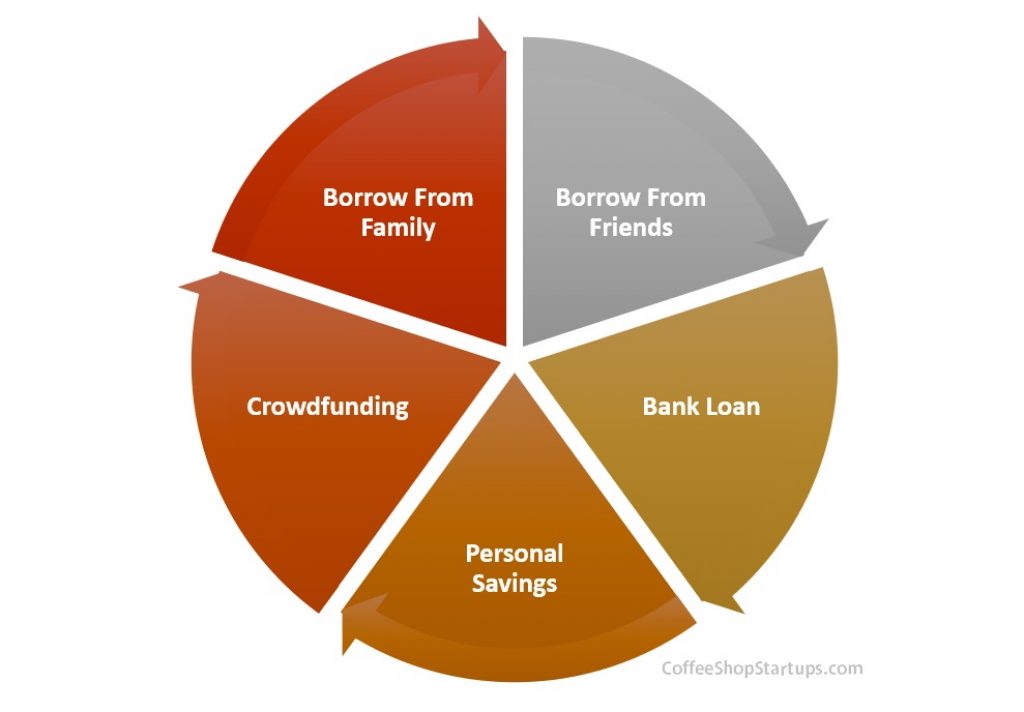
Choose your café roaster and vendors.
If you decide not to roast your beans, you will need to work with a wholesale coffee roaster .
Choosing a coffee roaster is a big decision. After all, you are banking on their expertise, quality, reliability, and their ability to provide you with as much roasted coffee as needed. Some cafes run through hundreds of pounds of coffee in a week, so your wholesale roaster will need to be able to fulfill those orders.
You may decide to roast your coffee beans yourself, but this decision comes with added costs and other considerations.
In addition to your coffee roaster, you should consider looking at any vendors you might need to work with to fulfill your menu items.
For further reading, please read How to Choose a Wholesale Coffee Roaster .
Build Out Your Café.
After securing your café location and signing your lease, you will probably need to remodel or build out your café. This may require some permitting, and it certainly requires some research to understand what codes and regulations you'll need to adhere to.
My recommendation is that you start early in the cafe design and layout process. Even though you may not have a location yet, you can still understand what is required for you to pass the inevitable health and building inspections. Establish contacts with your various departments. Never start working on your café without first checking with the agencies that will need to approve your design and layout.
Get your cafe license and permits.
You will need to get your health department permit, building permit, and business license to serve your first customer. Additionally, you may also need to have a fire department permit.
Each of these permits requires you to work with different governmental agencies before opening your café. The good news is that most of these agencies have worked with many café businesses in the past, so they would help you answer any questions you have.
Some agencies, like the building department, might be at the state level. In comparison, other agencies like the health department will be at the county or city level.
Develop a coffee brand & marketing strategy.
Setting your café apart from the rest of the field, in most cases, will be what allows your café to grow into the business you want it to.
You will want to create a brand – everything from your name, logo, slogan, and colors you use.
Your brand will be your banner symbol with which you, your employees, and your customers understand and develop a connection.
As you develop your café brand, you will also want to market your café business. Never believe that your café will succeed on its own simply with the fact that it exists.
Successful cafés figure out ways to effectively market to their target market. By understanding your target market and what you intend to do well, you can craft an effective marketing strategy.
Hire amazing baristas.
One of the best things you can do as a café owner is to hire amazing baristas and staff.
Reliable, honest, and skilled staff are hard to come by, so start looking for them early.
Once you hire your staff, do whatever it takes to keep morale high, pay fair wages, offer the opportunity for gratuity sharing, and provide regular barista training. Regular coffee education and barista training will improve your turnover rates.
Deliver excellence every time
Consistently deliver your best. If you have come this far to open your café, you will want to exceed your customers' expectations every time. I acknowledge that delivery consistency every time is hard, but it is necessary when your competitors are hoping you fail.
As a café owner and manager, you will want to offer high-quality products and services by constantly improving, continuously training, adapting, and listening to your customers. Treat your employees well, take steps to show how valuable they are to your business, and go the extra mile for your customers.
Further Reading : How to Start a Coffee Shop Successfully
Opening a Café Business

Additional Questions:
Is it hard to open a café.
Starting a café is not necessarily hard. Instead, it requires devotion and tenacity. There are several steps to owning and operating a café, and they all need to be completed before you can open your doors.
It will be challenging to have the patience, knowledge, and money to get you to the Grand opening. However, many successful café owners who started with less skill, less money, and less understanding than you, have succeeded because they had the motivation and devotion to follow through. Following through is the hardest part about starting a cafe.
How much money do café owners make?
Café revenue and income vary across the board. However, factors that determine café income and revenue aren't different from those of other retail businesses and restaurants.
To determine income, you'll need to determine how many sales you have per day, week, or month. Additionally, the number of sales needs to be multiplied by the average cost per ticket.
For example, let's take a tiny café open from 7 am to 7 pm, which sells 120 coffees per day, averaging $5 per receipt. That comes out to $600 per day or $4200 per week for coffee. So, this would come out to $16,800 per month.
Of course, this includes coffee alone and not muffins, pastries, soups, or other menu items. Additionally, you will want to subtract the operational costs to give you your café's net income and profits.
We take a deeper dive into the revenue and income that is generated by a coffee shop in our article, How Much Does a Coffee Shop Owner Make?
What is the difference between a cafe and a coffee shop?
A cafe is typically larger and offers indoor (and possibly outdoor) seating. Cafes may also offer waiting services and have a deeper menu. The menu may offer full-kitchen options for breakfast, lunch, and dinner. There are often different hybrid cafes that also offer walk-up or drive-thru options, but typically, you'll find a place for customers to sit, look at a menu, order from their items, and wait for their plates to be brought to them. A cafe may often be open later into the evening, serve alcohol , and offer live music.
Should I open up a low-cost coffee business instead?
If you would like to open a café but aren't sure you can manage the cost or secure funding, there may be a variety of other low-cost café options for you to consider.
Options include starting a mobile coffee business, an espresso catering business, or a drive-thru coffee stand . Additionally, you may also consider selling coffee online. Selling coffee online can help you establish your brand, help you target your customers, and provide you with the experience and funding you need to get your café started.
For more information, read Low-cost Ideas for Starting a Coffee Shop with No Money.
Are You Ready To Get Started?
Unlock Your Dream Coffee Shop Business with Our Exclusive Coffee Shop Startups Kit!
Ready to transform your passion for coffee into a thriving business? Look no further! Our Coffee Shop Startups Kit is your key to brewing success. Here's why you can't miss this opportunity:
Includes Exclusive BONUS Material!
👉 Order Now and Begin Your Journey!
Don't let the complexities of starting a coffee shop overwhelm you. Our Coffee Shop Startups Kit is your ticket to entrepreneurial success. Take the first step towards owning a profitable and fulfilling coffee business today.
Join the thousands of successful coffee entrepreneurs who started with a dream and a great plan. Your journey to coffee shop greatness begins right here!
Comprehensive. Proven. Affordable.
The Complete Coffee Shop Startup Kit
(Instantly Delivered To You)
Coffee Shop Startups
Based in Seattle, Washington, USA, Coffee Shop Startups is dedicated to providing you with the most relevant information on how to start a coffee shop business successfully. Over the last 11 years, we've helped thousands of aspiring coffee business owners worldwide. We harness the experience, wisdom, and knowledge of many successful coffee shop owners to help you increase your chances of success and profits. We support business owners who want to start a coffee business by providing them with valuable information on starting their coffee business successfully.
- Coffee Blog
- Mobile Coffee Coaching
- Testimonials
- Frequently Asked Questions
- Refunds, Terms & Conditions
All of our kits are delivered digitally. No physical delivery is made.
Based in Seattle, Washington, USA, Coffee Shop Startups is dedicated to providing you with the most relevant information on how to start a coffee shop business successfully.
Over the last 10+ years , we’ve helped thousands of aspiring coffee business owners worldwide. We harness the experience, wisdom, and knowledge of many successful coffee shop owners to help you increase your chances of success and profits.
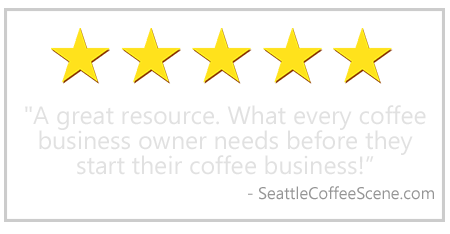
Your trust in us is important. Buy securely online with our Teachable Payment System. We have a no-hassle 14-day refund policy. Email us, and we’ll refund your money within 14 days of your purchase. Please read our testimonials from satisfied customers!

Disclaimer: The information and advice presented through this site and its products should not be considered legal or financial advice. The information within the website, affiliated websites, blogs, and any communications (electrical or otherwise) are for educational purposes only.
The author and publisher make no representations or warranties regarding the outcome or the use of the information within this website and products and are not assuming any liability for any claims, losses, or damages arising from the information.

- QR Code Menu
Table of Contents
Dreaming of opening a coffee shop? You’re not alone. The coffee industry is bustling with passionate business owners eager to make their mark. However, becoming successful coffee shop owners requires more than just a love for the brew. It demands a clear vision that differentiates your coffee house in a saturated market. A well-crafted business plan not only gives life to your idea but also sets your business on a path to thrive. Whether you’re a newbie or a seasoned entrepreneur, this guide, complete with a free template, will help you craft a business plan that markets and propels your coffee venture to success.
What is A Coffee Shop Business Plan?
A coffee shop business plan is a comprehensive document that explains what your business idea is, how you intend to penetrate the coffee market, and the strategies you’ll employ to run your coffee shop successfully. When opening a cafe, many aspiring cafe or coffee shop owners underestimate the value of a structured plan. However, this document does more than just outline the needs to open a coffee shop; it gives a detailed roadmap for your new business, offering clarity on every aspect of its operation.
More than that, presenting a well-structured business plan to potential investors is essential. It not only showcases your commitment but also your understanding of the industry, making it a vital tool for securing funding. While crafting a business plan can seem daunting initially, it’s the foundation that both clarifies your idea and sets your business on the trajectory for growth and success in the competitive world of cafes and coffee shops.
Why A Business Plan Is Important For A Successful Coffee Shop Business?
1. Clear Vision and Objectives
When you set up your coffee shop, having a business plan establishes a clear vision and defines your objectives. It is the backbone that steers every decision you’ll make. Without a clear outline, you may find yourself swaying from one idea to the next. With a detailed business plan, you can present a clear business proposal to stakeholders, ensuring them and yourself of the path you plan to tread.
2. Financial Planning
A comprehensive business plan is imperative for accurate financial planning. It will include information on how much capital is required to start, what your ongoing costs will be, and the revenues you plan to generate. If you’re seeking external funding, investors will want to see how you plan to use their money, and most importantly, how you plan to make a return on that investment. If you plan to sell specialty blends or unique treats, the financial section can also help you plan a strategy for pricing, promotion, and sales forecasts.
3. Operational Efficiency
Operational efficiency is the linchpin that holds all business operations together. A business plan will map out every detail, from supplier agreements to employee schedules. You may want to create special events or loyalty programs for regular customers, and this is where a business plan can help you plan a strategy for success. It becomes the reference point, ensuring that daily tasks align with the broader objectives, guaranteeing that resources, time, and efforts are used optimally.
Step-by-step Guide To Write A Coffee Shop Business Plan
1. Executive Summary
The Executive Summary is like the introduction of a novel – it provides a snapshot of what is to come. Typically, you write the executive summary last, even though it appears first in your business plan. It encapsulates the essence of your coffee shop’s mission, objectives, and financial overview, succinctly explaining what your business concept is about. This section is crucial because many coffee shops fail to engage potential investors right off the bat. Ideally, it should be concise – a page or two.
What should you cover in an Executive Summary?
- Introduce Your Coffee Shop or Cafe: Provide a company overview, giving readers insight into what makes your coffee shop unique from the myriad of coffee bars in the market.
- State Your Mission and Vision: Describe what drives your coffee business and where you see it in the future.
- Outline Your Objective: Define clear, measurable goals that you aim to achieve.
- Provide a Financial Overview: Highlight projected profit margins, a brief balance sheet, and other pertinent financial data.
2. Coffee Shop Business Description
This section paints a picture of your coffee shop. It’s where you elaborate on how you plan to infuse the local coffee market with your unique brews and pastries.
What should you cover in the Coffee Shop Description section?
- Coffee Shop Concept: Dive into the types of coffee drinks you plan to offer, whether it’s a rich espresso or a classic brewed coffee.
- Unique Selling Proposition: Discuss what makes your coffee shop stand out, be it a special blend of coffee beans, a unique roasting method using a specific coffee roaster, or artisanal pastry offerings.
- Operational Plan: Briefly touch upon how you’ll manage your coffee shop, from sourcing beans to serving cups of coffee.
3. Market Analysis
Before pouring your first espresso, performing market research before starting your coffee business is essential. This section dives deep into understanding your potential customer base and the coffee industry landscape in your area.
What should you cover in this section?
- Target Market: Describe your ideal customer. Are they local residents, office workers, or students?
- Location: Discuss the significance of your chosen location. Are there many coffee shops in the area? How does your location cater to your target market?
- Competition: Analyze existing coffee shops. What coffee and food products do they offer? What pricing strategy do they employ? How will your coffee shop compete or complement them?
4. Organization and Management
Behind every successful coffee shop is a robust organizational structure and a competent management team.
What should you cover in the Organization and Management Plan?
- Coffee Shop Ownership Information: Highlight the business’s legal structure.
- Profiles of Your Coffee Shop Management Team: Include details about your baristas, perhaps a part-time accountant, and someone to manage marketing. It can be helpful to create profiles for each role, detailing responsibilities and expertise.
5. Sample Menu
Your menu is the heart of your coffee shop. It’s more than just a list of coffee and tea; it’s an expression of your brand.
What should you consider when creating a Sample Menu?
- Menu Items: Detail the types of coffee, espresso drinks, and pastries you plan to offer. Maybe consider including non-coffee items like teas or specialty drinks.
- Unique Selling Proposition: Reiterate what makes your coffee or food items different from other coffee shops in the area.
- Menu Pricing : Discuss your pricing strategy, keeping in mind profit margin, competitors’ prices, and your target customer base.
6. Marketing Plan
To brew success, it’s not enough to have a fantastic coffee product; you must effectively market it.
What should you cover in a Marketing Strategy for your Coffee Shop Business?
- Define Your Brand: What voice, theme, or emotion do you want your coffee shop to evoke?
- Lay out your plans for social media campaigns, local partnerships, loyalty programs, SEO for website, and other promotional strategies.
- Considering using an online food ordering system in your food truck
- Create a digital menu with QR code to make your menu easy for your customers to access online
7. Operations Plan
Efficiency is key to the daily grind of running a cafe. The operations section provides a detailed look at the day-to-day operations of your coffee shop business.
What Operational Issues should you address in your Business Plan?
- Supply Chain: Where will you buy your coffee beans? Who will be your coffee roaster?
- Operating Hours: Consider the best times to cater to your target market.
- Staffing: Detail roles, such as barista, manager, and part-time support.
- Equipment: List down essential equipment, from espresso machines to ovens.
8. Financial Plan
In this crucial section of your business plan, delving into the financial specifics is paramount to lay out a concrete roadmap for the fiscal aspects of your coffee shop.
How Much Does It Cost to Start a Coffee Shop?
Starting a coffee shop is not just about brewing the perfect espresso; it’s also a substantial financial commitment. The cost for opening a coffee shop can range from $80,000 to $250,000. These costs can vary widely based on factors such as location, size of the establishment, equipment quality, and inventory requirements. Moreover, the process of opening a coffee shop might also involve unexpected expenditures, so it’s essential to account for some buffer in your budget.
How Many Ways to Fund Your Coffee Shop?
There are multiple avenues for funding your coffee venture. Traditional bank loans, personal savings, angel investors, crowdfunding campaigns, and partnerships are just a few options. It’s crucial to assess which option aligns best with your business vision and financial situation.
Important Questions to Consider When You Create Your Funding Request If you’re seeking funding, there are several questions you’ll need to answer in your business plan:
- How much money do you need to start and maintain your coffee shop until it becomes profitable?
- What will the funds be used for specifically?
- How do you plan to handle financial challenges that might arise?
- How do you plan to repay any loans or provide a return on investment?
9. Financial Projections
The financial projections section of your business plan forces you to translate your coffee shop vision into numbers, ensuring you’ve accounted for all key metrics that can make or break your venture.
Break-even analysis:
This is the point where your coffee shop’s total revenues equal its total costs. Simply put, it’s when you neither make a profit nor a loss from selling coffee.
Use this formula: Fixed Costs / (Price – Variable Costs) = Break Even Point
Projected profit and loss statement:
This will provide a forecast of your expected income and expenses, giving a clear view of your venture’s profitability.
Cash flow analysis:
Essential for understanding the liquidity of your business, this tool is especially crucial for coffee shops, considering the fluctuating expenses and incomes coffee shops offer. When drafting this, consider who will read it, as stakeholders like investors or lenders might have specific expectations.
Coffee Shop Business Plan Template
- Mission: To offer the community high-quality coffee in a comfortable and vibrant environment.
- Vision: To become the go-to local coffee spot that fosters community connections and coffee appreciation.
- Coffee Shop Description: “Java Junction” will be a modern coffee hub that emphasizes direct-trade coffee beans and a relaxed, inclusive atmosphere.
- Costs: Estimated initial costs are $125,000.
- Profits: Projected annual profit by year two is $75,000.
2. Description of the Coffee Shop
- Coffee Shop Concept: A community-focused café emphasizing artisanal methods.
- Coffee Shop Name: Java Junction
- Coffee Shop Type: Sit-down café with an adjacent mini-library.
- Location: Main Street, Downtown Area – chosen for its high foot traffic.
- Order Fulfillment: Orders taken at the counter with table service for food.
- Working Hours: Mon-Fri (7 am – 9 pm), Sat-Sun (8 am – 10 pm).
3. Menu Offer
- Type of Food and Drink: Coffee, teas, pastries, and sandwiches.
- Offer: From classic espresso shots to unique blends like “Lavender Latte”.
- Unique Selling Point: Every coffee product uses direct-trade beans, ensuring farmer fairness.
4. Market and Competition Analysis
- Market Analysis: The local population includes a mix of professionals, students, and tourists. Many search for quiet spots to work or relax.
- Target Customer: Professionals aged 25-40 and students.
- Size of the Target Customer: Approximately 15,000 individuals.
- Competition Analysis: Three established coffee shops within a mile.
- Size of the Competition: Ranging from small boutique coffee shops to a larger chain.
- Competitors’ Offer: Basic coffee drinks, with limited specialty items.
- Competitors’ Prices: Average of $4 for a coffee drink.
5. Investment Plan (Detailed Cost Analysis)
Investment Cost (One-off): $75,000
- Equipment: $30,000
- Renovations: $20,000
- Initial Stock: $10,000
- Licenses: $5,000
- Miscellaneous: $10,000
Operating Costs (Monthly): $17,000
- Rent: $3,000
- Salaries: $10,000
- Utilities: $1,000
- Stock: $2,000
- Marketing: $1,000
6. Financial Forecast
Year one is projected to break even, with a profit of $50,000 expected in year two, and $75,000 in year three, considering growth and expanding customer base.
- Owner: Jamie Smith, a coffee enthusiast with a business degree.
- Manager: Alex Brown, previously managed a successful coffee chain for five years.
- Baristas: A team of 4 skilled individuals passionate about coffee.
8. Marketing Plan
Java Junction will use a mix of social media marketing, local print advertising, and loyalty programs to attract and retain customers. Regular events, such as “Buy Our Coffee Day” and collaboration with local businesses, will drive foot traffic and community engagement, integral components for starting your coffee shop and making it successful.
This coffee shop business plan sample is hypothetical and serves as a template. Tailoring specifics to your local market, vision, and unique aspects will be necessary. Every coffee shop has nuances that can make them successful, whether it be the coffee products they sell, the environment they cultivate, or the events they host. Focus on what will make your coffee shop stand out and be sure to engage your community.
Tips For Writing a Business Plan For a Coffee Shop
Your business plan becomes the blueprint of your vision. Here are essential tips to consider:
Comprehensiveness is Key: Ensure your plan encompasses all sections you should include, such as marketing, financial projections, and operations. A well-rounded plan provides a holistic view of your business.
Tailor to Your Audience: If you’re presenting to potential investors, focus on profitability and growth projections. For a landlord, emphasize the benefits your coffee shop will bring to their property.
Specialize in Marketing: Given the competitiveness in the coffee industry, it’s crucial to have a solid marketing plan. If marketing isn’t your strength, consider hiring someone to do marketing for your venture. A strong online presence, loyalty programs, and community engagement can set you apart.
Research Your Market: Understand what nearby coffee shops include in their offerings. Identify gaps in the market and strategize on how your shop can fill them.
Stay Flexible: While a business plan provides direction, remain adaptable. The coffee industry is dynamic, and your ability to pivot can prove invaluable.
Separate Sections for Clarity: If your plan becomes too dense, you might want to create a separate document for specific sections like a detailed marketing strategy or an in-depth market analysis. This makes your primary business plan concise and more readable.
Frequently Asked Questions
1. how profitable is owning a coffee shop.
Owning a coffee shop can be profitable, depending on factors like location, quality of products, and management. On average, after expenses, many coffee shops report a profit margin of around 3% to 5%, with some successful ones achieving even higher. However, it’s essential to factor in initial setup costs, ongoing expenses, and market competition.
2. How do I start a coffee shop business plan?
Starting a coffee shop business plan involves multiple steps. Begin by defining your coffee shop’s mission and vision. Conduct market research to understand your target audience and competitors. Then, detail out sections like your product offerings, pricing strategy, marketing plan, financial projections, and operational procedures. If you’re thinking of opening a coffee shop, a well-thought-out business plan is indispensable.
3. What is a business plan for a coffee shop?
A coffee shop business plan is a detailed document that outlines your coffee shop’s objectives, strategies, and operational procedures. It acts as a roadmap, guiding you from the startup phase to establishing a thriving business. Moreover, if you need a coffee shop business loan or investment, this plan becomes crucial in convincing stakeholders of your venture’s viability.
4. What are the 4Ps in a coffee shop business plan?
The 4Ps stand for Product, Price, Place, and Promotion. In the context of a coffee shop:
- Product: What type of coffee and related products will you offer?
- Price: How will you price your coffee? Will it be premium or competitive?
- Place: Where will your coffee shop be located? Is it accessible to your target audience?
- Promotion: How will you market your coffee shop? Will you offer promotions or loyalty programs?
These elements help in creating a marketing strategy tailored to your coffee shop’s unique needs and market position.
Launching a coffee shop is not just about brewing the perfect cup but weaving a narrative that resonates with your community, fostering an ambiance that people gravitate towards, and maintaining a seamless operation that drives profitability. The meticulous creation of a business plan is a pivotal step in this endeavor. It’s the beacon that guides budding entrepreneurs through the complexities of the coffee industry. In such a competitive marketplace, a well-structured, comprehensive business plan can make the difference between a fleeting venture and a thriving institution. To potential coffee shop owners, embrace the process, let your passion shine through in your plan, and remember that every great coffee shop started with a simple idea, much like a single coffee bean ready to brew greatness.

Related articles

QR Code on Table Tents for Restaurants and Bars

How much does it cost to open a small restaurant

How much does it cost to open a bakery
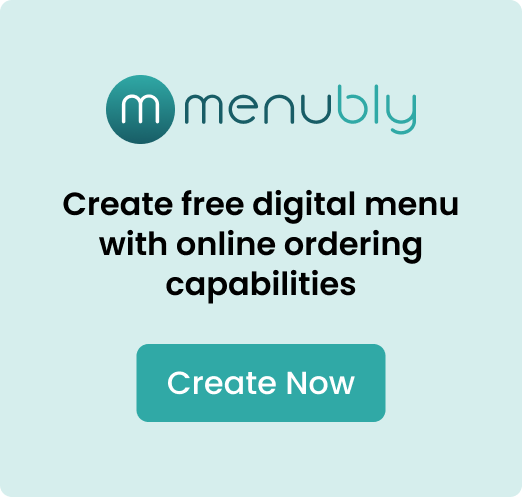
Menubly LLC 8 The Green Suite R, Dover, Delaware 19901
Privacy Policy
Terms of service
Cookie Policy
Upmetrics AI Assistant: Simplifying Business Planning through AI-Powered Insights. Learn How
Entrepreneurs & Small Business
Accelerators & Incubators
Business Consultants & Advisors
Educators & Business Schools
Students & Scholars
AI Business Plan Generator
Financial Forecasting
AI Assistance
Ai Pitch Deck Generator
Strategic Planning
See How Upmetrics Works →
- Sample Plans
- WHY UPMETRICS?
Customers Success Stories
Business Plan Course
Small Business Tools
Strategic Canvas Templates
E-books, Guides & More
- Sample Business Plans
- Food, Beverage & Restaurant
How to Write a Coffee Shop Business Plan + Free Template

You are a smart entrepreneur. You don’t jump right in and open a coffee shop just because you decoded the secret of making perfect cups of steaming delicious coffee.
Instead, you wait and plan to write a unique business plan that resonates with your coffee shop’s concept.
But hey, writing a business plan is actually complex. Without any structural format or direction, you may end up making a hotchpotch of your business idea.
To ensure that your business concept translates properly into a plan, we created this step-by-step guide that will prompt you to write an insightful coffee shop business plan in great detail.
Also, get a free coffee shop business plan template that has all the relevant examples for you to get started.
So get yourself a cup of coffee and decode the secrets of writing a stellar plan in easy steps.
Let’s get started.
Key Takeaways
- Craft a compelling executive summary for your coffee shop business plan. Add key details regarding financials, marketing, business objectives, and operations to help investors evaluate your business idea.
- Conduct thorough research on the coffee shop market by analyzing the key trends, consumer preferences, and needs of your target market.
- Streamline your coffee shop operations with a detailed plan outlining the standard operating procedures of your key business processes.
- Ensure the compliance of business by acquiring essential licenses and permits.
- Design a brief sales and marketing plan to ensure that the coffee business reaches its target customer and starts making sales.
- Identify your unique selling proposition and determine your competitive edge in the market.
- Using SWOT analysis, analyze the strengths, weaknesses, opportunities, and threats of your competitors and your own business.
- Create a sample menu and determine your menu offerings by considering varying different aspects.
Why Prepare a Coffee Shop Business Plan?
A lot of variables play together to write the success story of your coffee business.
From choosing a shop location to remodeling it as per your unique concept, hiring staff, determining sales strategy, acquiring licenses and insurance, and planning operations-you need to undertake multiple activities, consecutively at a time, to start and run a coffee business.
A business plan will guide you like a map in the right direction. It will ensure that all the business objectives are achieved without breaking a compliance code.
It forces you to assess the viability of a coffee shop idea before you invest the money in it. You can strategically plan the coffee shop’s success by making detailed financial projections relating to the company’s sales, revenue, costs, and expected expenses, and cash flow.
And most important of all, a business plan will help you acquire the required funds by winning the trust of potential investors.
How to Write a Coffee Shop Business Plan: A Complete Guide
Let’s walk through the process of writing a coffee shop business plan with detailed step-by-step instructions.
1. Get a business plan template
Writing a business plan from scratch is pretty exhausting. You are likely to leave behind an important detail without any structural format.
So do yourself a favor and get a business plan template. Trust us, it’s going to make your plan writing process so much simpler.
A template helps bring clarity and focus to different sections of the plan by prompting you in specific directions. Moreover, the templates contain examples and tips specific to coffee shops making it extremely relevant for your business.
Looking for a well-structured and modern business plan template?
Well, we knew you would. Presenting the Upmetrics business plan template that can be easily customized for your unique coffee shop business. Simply download our template and modify it as per your business concept.

Need Assistance Writing a Coffee Business Plan?
Get Upmetrics’ business plan template, import data directly into the editor, and start editing using Upmetrics AI Assistant.

Start Planning Now
2. Write an executive summary
An executive summary is like a north star of your business plan. It will act as a guiding light for stakeholders to understand your journey ahead.
Investors will read the executive summary of your coffee shop business plan before even allowing you a presentation. So definitely it needs to be compelling and converting.
Keep your executive summary concise but detailed enough that it summarizes the key points of your entire plan. Include the problems you would be solving and the solutions you have to offer. Adapt a storytelling tone and focus on highlighting the business goals, financials, objectives, and overall business strategy.
Now, move ahead and visit this part when you are done writing for the entire plan. Summarizing becomes much easier and more effective when you are aware of the entire plan’s details.
Also, two pages are more than enough for writing a capturing executive summary.
3. Conduct a competitive and market analysis
Build a strong foundation for your coffee business by diving deep into the market research of the coffee industry, competitors, target audience, market trends, and your attainable target market.
Analyze the coffee shop industry from a macro viewpoint and then gradually narrow it down to your particular market. For instance, the revenue in the US coffee market size was $85.2 billion in 2022 and is expected to grow by 3.21% between 2023-2028.
Now, identify your targeted available market (TAM) from this and analyze the growth potential of your particular coffee shop. Overall, try to show that the coffee shop business has a thriving opportunity to grow in the market.
The market analysis for a coffee shop business must include the study of the following:
Customer analysis
Customer analysis is essential to identify your target customers. Having a thorough understanding of your target market will help formulate the business and market strategies appropriate for your business.
Create the buyer persona of your ideal customer. Focus on these details to outline your ideal customer:
- Customer demographics: Age, gender, location, income, occupation, and ethnicity of the customers who will visit your coffee shop.
- Customer psychographics: Beliefs and values of your ideal customer, their interests, spending pattern, and their media consumption.
For instance, the ideal customer for Steamy Sips is 23-38 years old and works in a corporation. He/ She likes to spend money on coffee regularly and prefers fresh roasted seasonal brews, is socializing, and loves working in a cafe remotely.
Competitors analysis
After determining your target market, look around and identify your potential competitors.
Begin by identifying the top competitors of your coffee shop. This can be neighboring coffee shops, kiosks, or coffee karts that offer similar services to your business.
Now conduct a SWOT analysis of these coffee shops by analyzing their strengths and weaknesses. Also, analyze your strengths against competitors and highlight your competitive edge in the market. Be realistic with your assessment as this will form the foundation of your related business policies.
Lastly, identify if there are any stellar opportunities for you to leverage in this market.
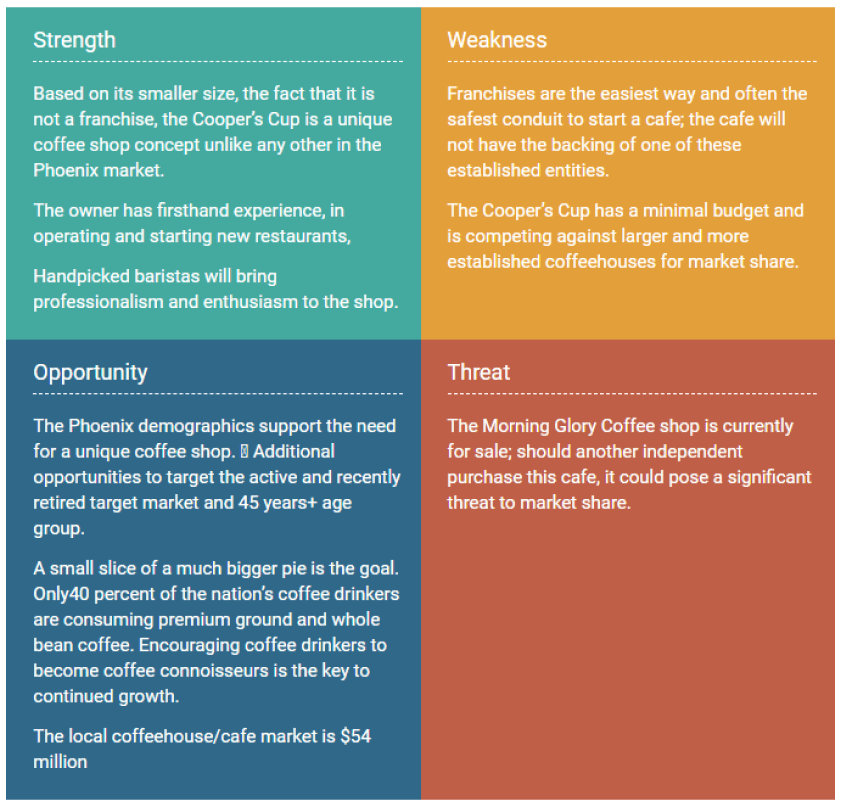
Collect data from highly authoritative websites, data publications, and local studies specialized in the coffee industry. For instance, SBA , SCA coffee , Mintel , Business Wire , COFFEEBI , etc.
This section is your chance to prove to the potential investors that you are aware of the market challenges and there exist favorable chances for your coffee shop to thrive and grow.
4. Prepare a company overview
Just like the executive summary of your coffee shop business plan, this section includes a brief business description of your coffee shop. It offers readers a peek into your business structure, goals, mission, and company values.
Depending on your market analyses choose the type and structure of your business concept. Clearly describe whether you will start a cafe or coffee shop, coffee kart, coffee bar, or coffee house and whether the business structure will be LLC, partnership, or sole proprietorship.
Further include your mission statement, coffee shop objectives, and goals to complete the company overview section.
Mission statement: A mission statement highlights the purpose of your coffee shop’s existence and its long-term objective.
For instance, Steaming Sips’ mission is to cultivate a culture of freshly roasted coffee, serving a welcoming space for young individuals to connect, create, and unwind with every cup of our brews.
Coffee shop objectives: In this part, highlight your business objectives in terms of milestones, growth goals, revenue goals, sales numbers, etc.
For instance, Steaming Sips aims to open 3 branches across San Fransisco by the end of 2025.
5. Present your sample menu
The market research earlier helped you understand your potential audience in great detail. Now, it’s time to decide what to offer on your menu.
A sample menu is an important component of your coffee shop business plan. With a menu, investors will know what exactly you will be serving and what makes you different.
A coffee shop can stand apart selling just coffee drinks. However, there are many coffee shops that sell coffee and food products together. Depending on your coffee shop concept and the target market, decide the menu items.
Here are a few things to consider while making your menu and establishing yourself as a specialty coffee shop.
- Different types of coffee drinks that suit your customer’s taste. For ex. filtered coffee, frappuccino, brewed coffee, hot coffee, etc.
- The type of coffee beans to produce high-quality coffee, e.g. organic coffee beans.
- Different types of coffee roasts, e.g. dark roast, medium roast, light roast.
- Different types of milk, e.g. plant-based milk options and dairy milk.
- Seasonal coffee specialties.
Strategically place the items in your menu and add the prices alongside. Incorporate branding elements of your coffee shop in the menu as well.
6. Coffee shop design and layout
Till now, the coffee shop idea was just a business concept, jumbled randomly across your mind. Writing a business plan will help you to sort those ideas, one section at a time.
The design and layout section helps potential investors visualize the appearance of your coffee shop. It is your chance to help them understand your coffee shop concept and the aspects that set you apart from other coffee shops.
Begin by highlighting your coffee shop location in this section. Briefly explain how the location is suitable for your potential customers.
Also, present the moodboard of your coffee shop and highlight the branding and visual elements of its design.
Overall, explain how you will create a welcoming atmosphere for your customers by incorporating design and decor elements in your shop.
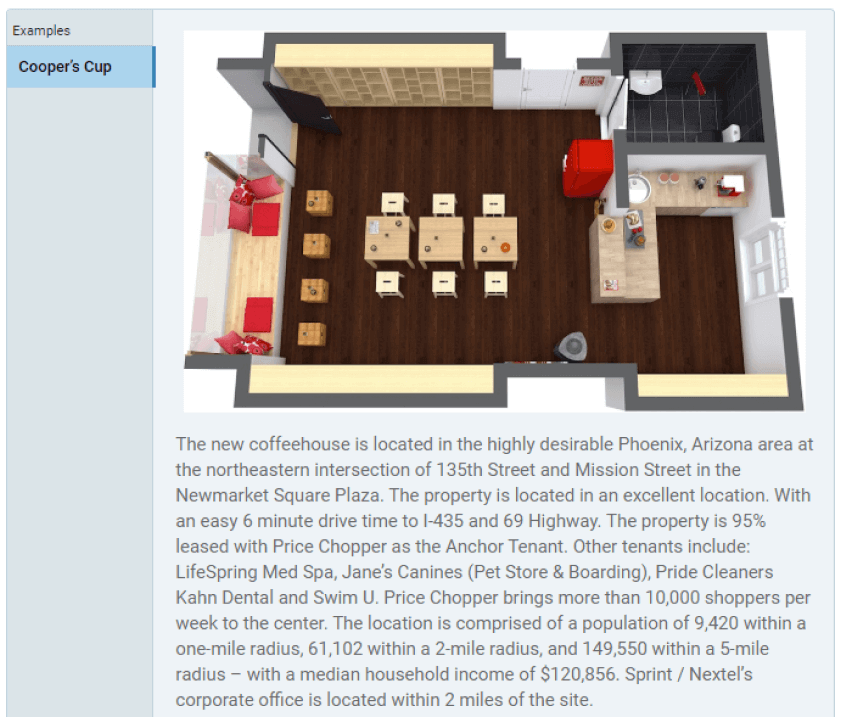
7. Prepare a coffee shop marketing plan
Now that you have the concept, design, and menu for a coffee shop, it’s time to work on its marketing plan. The coffee market is intensely competitive and only a solid marketing action plan can differentiate your business from other coffee shops.
Using your market research, identify the best marketing strategy for your business. Ideally, coffee shops build a cohesive brand image using a mix of digital marketing practices.
For instance, a website can be used to build a robust web image, while social media can be used to connect with your target audience organically. Similarly, your coffee shop emails can focus on special offers and promotional invites while paid ads can help you target the wider audience.
In this section, you also highlight various promotional activities for your cafe such as karaoke evenings, art workshops, musical nights, happy coffee hours, etc.
Overall a comprehensive marketing plan must answer the following questions:
- How will you draw coffee enthusiasts to your coffee shop?
- What will be the pricing strategy of your coffee shop?
- What will be your marketing budget?
- What marketing channels will you use and who will undertake the marketing activities?
- Will there be any promotional events at the cafe? If so, what type of events?
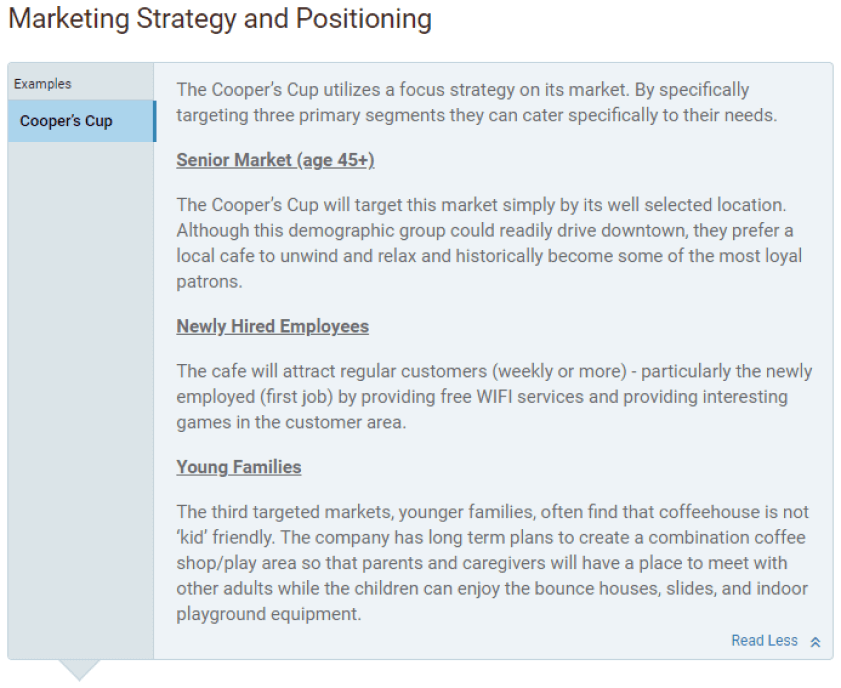

8. Introduce your management team
In this section, you will introduce the management team that will ensure the smooth functioning of your coffee shop business.
Begin by introducing the coffee shop owners and their relevant experience in the coffee market. Also, clarify if you will work both as owner and manager or hire a coffee shop manager to look after the day-to-day operations.
If you are going to hire a manager, introduce them and their key responsibilities in the section. Offer a brief description of their skills, experience, and expertise that can help your coffee shop business.
Overall, this section shows the potential investors that you have all the right people in a team to drive your coffee shop toward success.
9. Outline your operational plan
This section of a coffee plan offers brief details of everyday business processes that will guide you to build and run a successful coffee shop.
An operations plan includes a lot of details, answering some of these prominent questions.
- Inventory and stock management: How will you manage and track the inventory? Who will be responsible for stock management? How often would you restock the inventory?
- Production: Who will develop the recipes for coffee beverages? Will there be recipe cost cards for coffee preparation? Will there be kitchen staff working with food orders or will you outsource that?
- Coffee shop equipment: What equipment will you buy for the coffee shop, i.e. espresso machine, coffee grinders, etc? Will that be a new purchase or a second-hand one? How much will the equipment cost?
- Management: Who will serve the food and coffee in the shop? Who will look after customer complaints? What is the conflict resolution system at your coffee shop?
- Technology: What technologies will you use at your coffee shop? Which payment and POS system will you use? Will there be an ordering kiosk?
A well-planned operations plan demonstrates your ability to run a coffee shop to your readers. So keep it detailed and revamp it as and when needed.
10. Create a Financial Plan
A financial plan helps assess the viability of your business idea by evaluating its financial aspects. It’s an important part of your coffee shop business plan whether you want to seek funding or not.
A well-built financial plan is presented in numbers, graphs, and charts and includes the following:
- Evaluation of startup costs: Identify the startup costs of your proposed coffee shop. Take into account the costs for lease rental, licenses, equipment, remodeling as well as operating expenses for the first few months.
- Sales forecasts and pricing: Determine the drink sales for your coffee shop and your pricing structure by conducting market research.
- Operating costs: Your financial projections should include a thorough calculation of operating expenses to run a coffee shop business.
- Balance sheet: A balance sheet will help investors assess your assets and liabilities and the liquidity of your business.
- Cash flow statement: Make cash flow projections and demonstrate the inward and outward flow of money in the business.
- Income statement: The figures in this sheet help evaluate the profitability of your business
- Break-even analysis: The calculations here will help determine the sales level after which your coffee shop will start making a profit.
Now, making all these financial projections and calculations is a bit taxing. Not only that, you will have to create visual reports to make the financial section appealing and insightful.
Well, let’s make things easier with our financial forecasting tool. Simply enter your assumptions in a tab and our tool will generate important key reports for your business.
Don’t stress. You don’t need to worry about the visual reports anymore. Go, check your dashboard. You will have all the visual reports ready to be added to your financial plan.
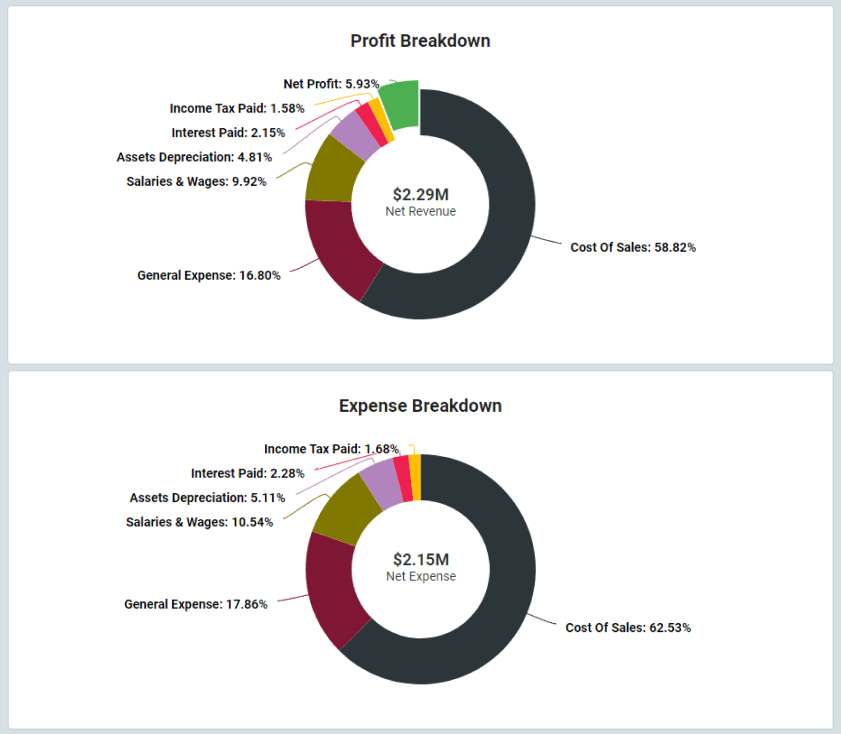
And that’s your detailed guide to writing your coffee shop business plan. Now, let’s check the latest industry trends ruling the coffee shop market.
Coffee Shop Industry Highlights 2023
Let’s dive further deep into market analysis with these latest industry trends in the coffee shop market:
- Coffee shop industry: The US coffee shop industry grew from $36 billion to 45.8 billion dollars between 2020-2022.
- Number of coffee shops: According to Statista , in 2022 there were a total of 38.4 thousand coffee shops in the US.
- Coffee drinkers: A performed market research indicates that the top coffee consumers aren’t youngsters, but seniors. Nearly, 70% of seniors consume coffee regularly.
- Employment growth rate: The total number of people employees in the coffee shop industry in th US increased on average by 4.9% between 2018-2023.
- Specialty coffee market: According to Grandview research , the US specialty coffee market is expected to grow at 10.9% CAGR between 2023-2030.
- Price per cup: According to Business Insider , the average price per coffee cup in the coffee shop is almost $5, making it an affordable luxury for people.
Related Coffee Shop Resources
- Coffee Shop Operational Plan
- Coffee Shop Financial Plan
- Coffee Shop Marketing Plan
- Latest Coffee Shop Business Trends
Download a sample coffee shop business plan
Need help writing your business plan? Let’s ease your plan writing process with our coffee shop business plan pdf . Download it for free and customize it as per your needs.
This modern intuitive template offers a step-by-step guide that will help you write a comprehensive and actionable business plan. It’s designed specifically for coffee shop businesses and includes examples relevant to your industry.
The Quickest Way to turn a Business Idea into a Business Plan
Fill-in-the-blanks and automatic financials make it easy.
Write your business plan with Upmetrics
Enhance the quality of your business planning with Upmetrics. With more than 400+ customizable sample business plans , it offers features like AI assistance to write an impactful business plan.
Whether you are starting your own coffee shop or taking over an existing coffee business, Upmetrics’ insightful guides and resources will help you craft a compelling business plan in easy steps.
Related Posts
Coffee Roaster Business Plan
Coffee Truck Business Plan
Financial Guide for New Startups
Cost To Start a Coffee Shop
Best Business Plan Writer
How to Start a Coffee Shop Business
Frequently asked questions, what are the key components of a successful coffee shop business plan.
The key elements of a coffee shop business plan are
- Executive summary
- Business overview
- Coffee industry and market analysis
- Sample menu
- Coffee shop design and layout
- Marketing and sales plan
- Key management team
- Operations plan
- Financial plan
Should we consider franchising our coffee shop?
Yes, you can. Franchising is a proven way of increasing the reach and profitability of your coffee business. Moreover, it’s easy to scale your business through a franchise business model.
What is a traditional business plan for a coffee shop?
A traditional plan is very similar to modern business plans. It includes a summary of the company’s goals, objectives, business values, marketing objectives, and financial plan. The modern plans, however, are intuitively designed to be more suited to investors interest.
Do I need a business plan to secure funding for my coffee shop?
Yes. Investors and investing firms will ask for a business plan before giving you a chance to present the coffee shop concept. By studying your plan, they will gauge the viability of your coffee business, and depending on the analysis they will decide whether to invest or not.
What should I include in the financial projections section of my business plan?
The financial projections of your coffee shop plan must include the following:
- Sales forecast
- Startup cost estimates
- Operating costs
- Balance sheet
- Income statement
- Cash flow statement
- Break-even analysis
About the Author
Upmetrics Team
Upmetrics is the #1 business planning software that helps entrepreneurs and business owners create investment-ready business plans using AI. We regularly share business planning insights on our blog. Check out the Upmetrics blog for such interesting reads. Read more
Plan your business in the shortest time possible
No Risk – Cancel at Any Time – 15 Day Money Back Guarantee
Popular Templates

Create a great Business Plan with great price.
- 400+ Business plan templates & examples
- AI Assistance & step by step guidance
- 4.8 Star rating on Trustpilot
Streamline your business planning process with Upmetrics .


500+ business plans and financial models
Coffee Shop Business Plan PDF Example
- February 28, 2024
- Business Plan
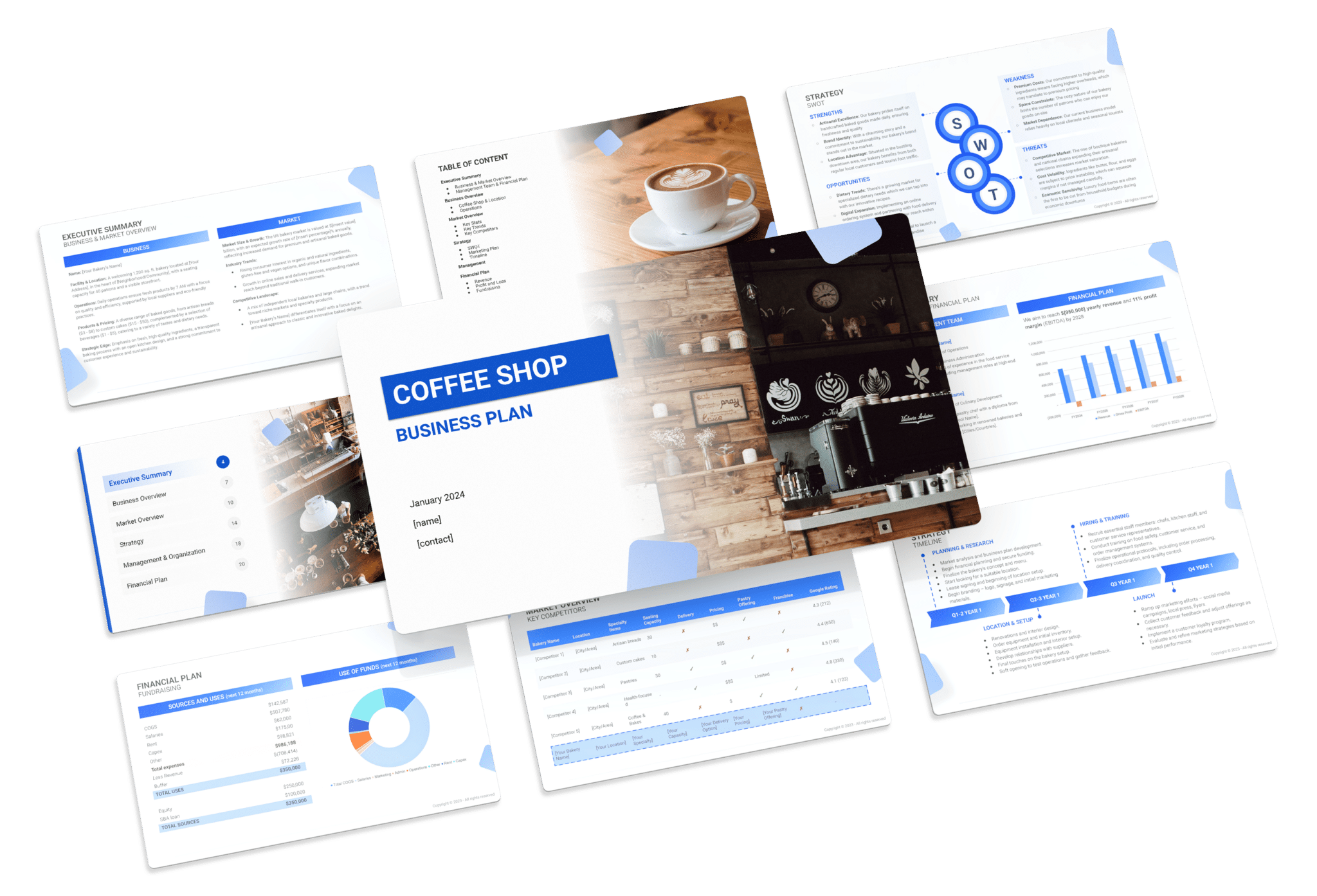
Creating a comprehensive business plan is crucial for launching and running a successful coffee shop. This plan serves as your roadmap, detailing your vision, operational strategies, and financial plan. It helps establish your coffee shop’s identity, navigate the competitive market, and secure funding for growth.
This article not only breaks down the critical components of a coffee shop business plan, but also provides an example of a business plan to help you craft your own.
Whether you’re an experienced entrepreneur or new to the food and beverage industry, this guide, complete with a business plan example, lays the groundwork for turning your coffee shop concept into reality. Let’s dive in!
Our coffee shop business plan is structured to cover all essential aspects needed for a comprehensive strategy. It outlines the shop’s operations, marketing strategy , market environment, competitors, management team, and financial forecasts.
- Executive Summary : Offers a quick look at your coffee shop idea, market research , your team, and money plans.
- Coffee Shop & Location: Talks about the design, special features, and why the spot is great for customers.
- Operations: Describes how your shop runs daily, like hours, staff roles, and your menu items with prices.
- Key Stats: Gives numbers on how big the coffee shop world is and what’s trending.
- Key Trends: Points out new things in coffee shops, like eco-friendly practices or tech for ordering.
- Key Competitors : Looks at other coffee places nearby and how your shop is different.
- SWOT: Lists strengths, weaknesses, opportunities, and risks for your shop.
- Marketing Plan : Ideas for getting the word out and keeping customers coming back.
- Timeline : Major steps and goals from starting up to the first year.
- Management: Highlights Info on your leading team and their roles.
- Financial Plan : Predicts financials for 5 years, like how much you’ll make, spend, and keep as profit.
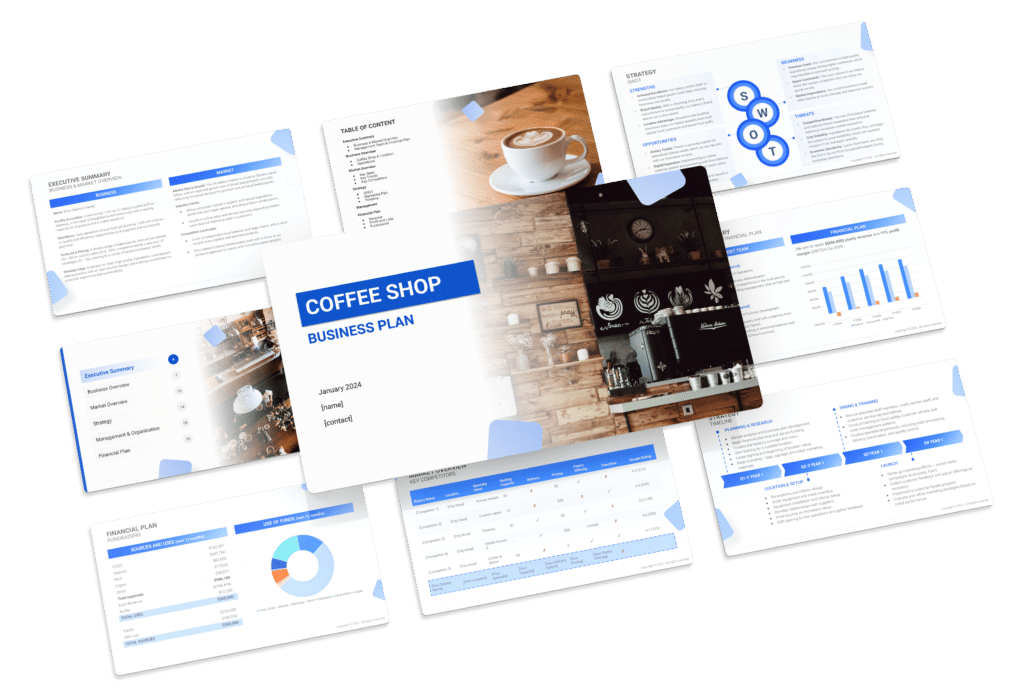
Coffee Shop Business Plan

✅ 30+ slides already completed
✅ Updated market research
Trusted by 12,000+ entrepreneurs, consultants and investors
Download an expert-built 30+ slides Powerpoint business plan template
Executive Summary
The Executive Summary presents a concise overview of your coffee shop’s business plan, encapsulating the essence of your establishment and its offerings. It should articulate your market positioning, the variety of coffee and related products you offer, its location, size, and a brief on the daily operations.
This section should also delve into how your coffee shop will carve its niche within the local community, including an analysis of the number of direct competitors in the vicinity, identifying who they are, as well as highlighting your coffee shop’s unique selling points that set it apart from these competitors.
Moreover, information about the management and co-founding team should be included, elaborating on their roles and the value they bring to the coffee shop’s success. Additionally, a synopsis of your financial projections, including anticipated revenue and profits over the next five years, should be provided here to offer a clear view of your coffee shop’s financial strategy.
Make sure to cover here _ Business Overview _ Market Overview _ Management Team _ Financial Plan
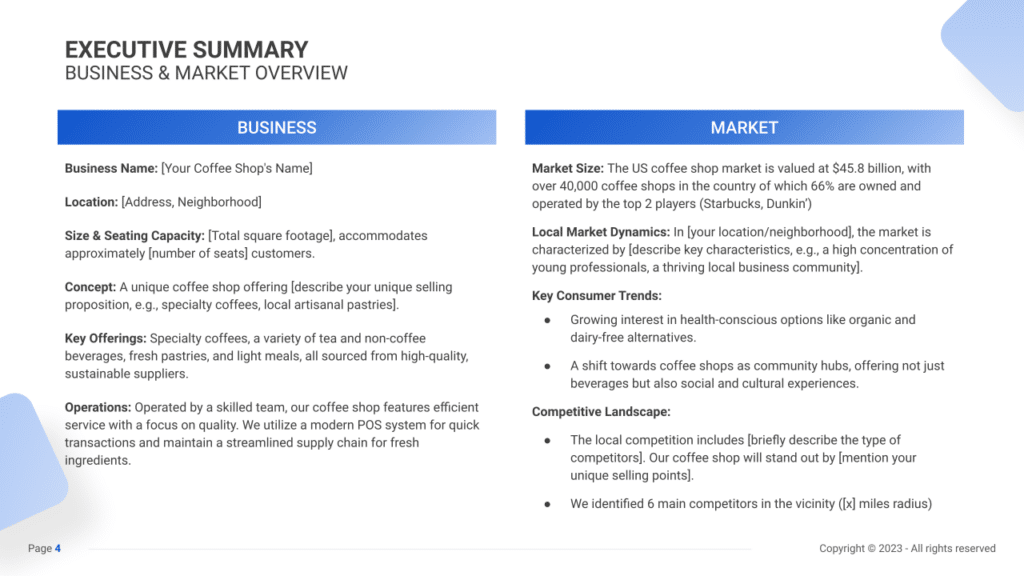
Dive deeper into Executive Summary
Business Overview
For a Coffee Shop, the Business Overview section can be neatly divided into 2 main slides:
Coffee Shop & Location
Talk about your coffee shop’s look and feel, highlighting cozy seats and nice lighting that make it welcoming. Mention its location, noting how easy it is to get there, like being close to shops or having easy parking. Explain why this spot is great for attracting customers.
Operations & Offerings
List the kinds of coffee and other items you sell, including snacks or light food. Discuss pricing, making sure it matches the quality of what you’re selling and suits your target customers. Share special features of your shop, such as using local products or offering unique coffee flavors. Mention any deals or events you have to keep customers coming back.
Make sure to cover here _ Coffee Shop & Location _ Operations
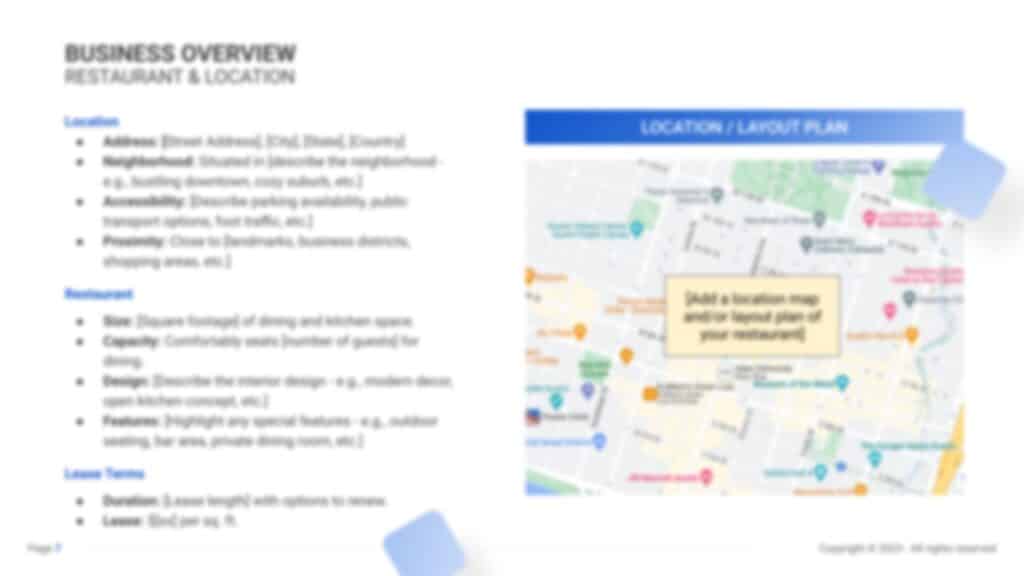
Market Overview
Industry size & growth.
In the Market Overview of your coffee shop business plan, begin by exploring the size of the coffee industry and its potential for growth. This analysis is key to understanding the breadth of the market and pinpointing opportunities for expansion.
Key Market Trends
Next, discuss current trends in the coffee market, like the growing demand for specialty coffee, the appeal of ethically sourced and organic beans, and the innovation in coffee brewing techniques. Highlight the interest in offerings that cater to diverse preferences and dietary needs, such as plant-based milk options and artisanal blends, as well as the increasing importance of sustainability in the coffee industry.
Key Competitors
Then, examine the competitive landscape, which encompasses a variety of coffee shops from high-end specialty cafes to more affordable, convenient options, as well as the rise of home brewing. Focus on what sets your coffee shop apart, whether it’s through top-notch customer service, a unique selection of products, or expertise in certain types of coffee. This section will underscore the demand for coffee shop services, the competitive atmosphere, and how your coffee shop is well-placed to succeed in this vibrant market.
Make sure to cover here _ Industry size & growth _ Key market trends _ Key competitors
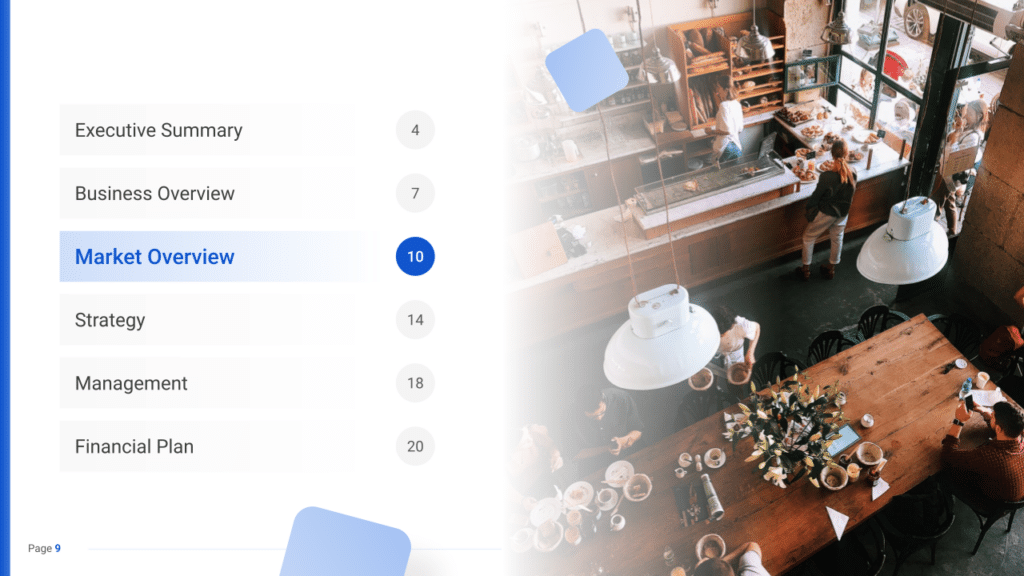
Dive deeper into Key competitors
Start by doing a SWOT analysis for the coffee shop. Point out Strengths (like skilled baristas and a variety of coffee options), Weaknesses (such as high running costs or lots of competitors), Opportunities (for instance, more people wanting unique coffee experiences), and Threats (like economic changes that might reduce how much people spend on coffee).
Marketing Plan
Then, make a marketing plan that shows how to draw in and keep customers. This could include ads aimed at the right people, deals to save money, an active and interesting online presence, and getting involved in the local area.
Lastly, set up a detailed timeline that marks important steps for the coffee shop’s start, marketing actions, growth in the number of customers, and goals for getting bigger. Make sure there’s a clear plan and goal for moving the business forward.
Make sure to cover here _ SWOT _ Marketing Plan _ Timeline
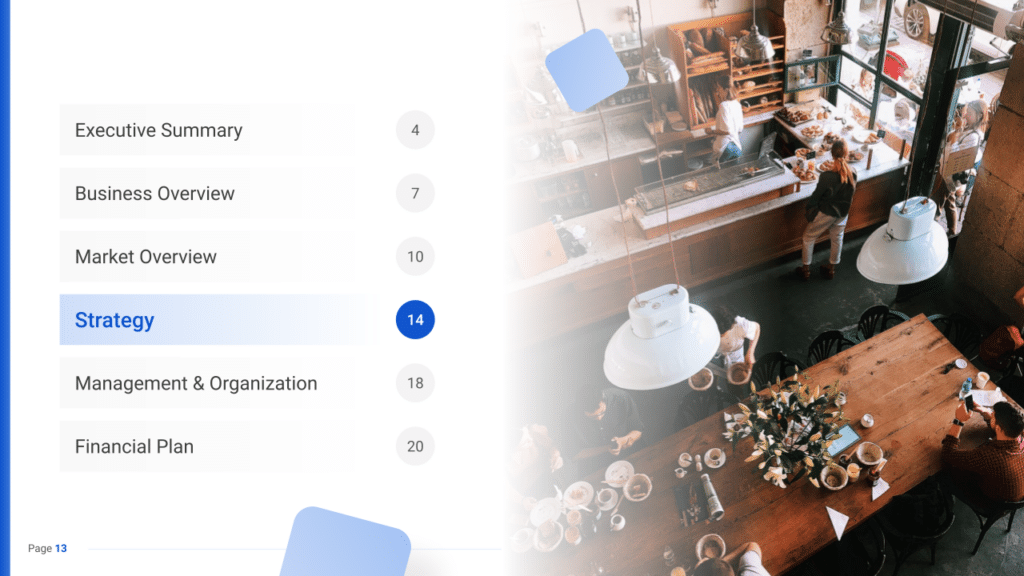
Dive deeper into SWOT
Dive deeper into Marketing Plan
The Management section focuses on the coffee shop’s management and their direct roles in daily operations and strategic direction. This part is crucial for understanding who is responsible for making key decisions and driving the coffee shop toward its financial and operational goals.
For your coffee shop business plan, list the core team members, their specific responsibilities, and how their expertise supports the business.
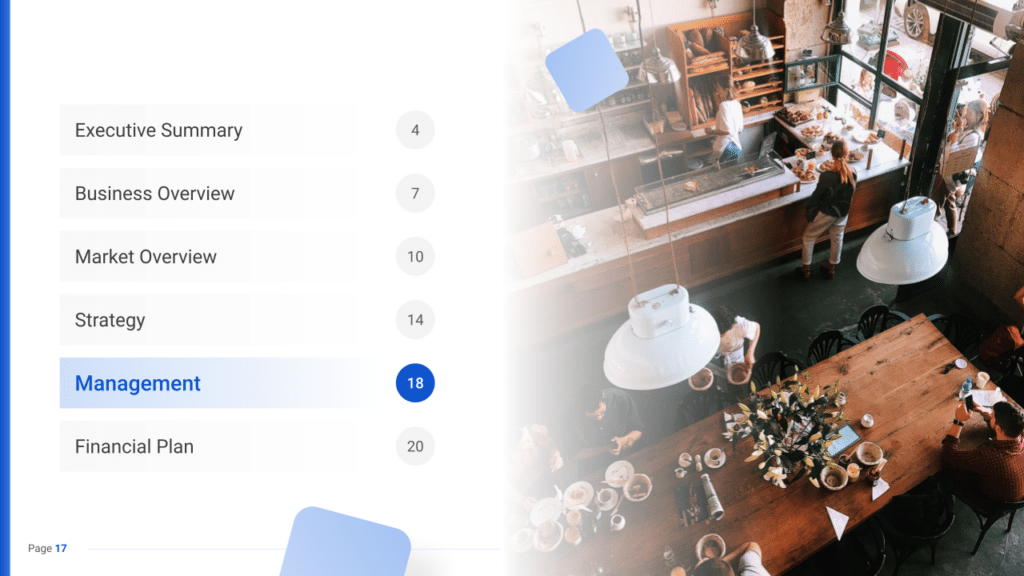
Financial Plan
The Financial Plan section is a comprehensive analysis of your financial projections for revenue, expenses, and profitability. It lays out your coffee shop’s approach to securing funding, managing cash flow, and achieving breakeven.
This section typically includes detailed forecasts for the first 5 years of operation, highlighting expected revenue, operating costs and capital expenditures.
For your coffee shop business plan, provide a snapshot of your financial statement (profit and loss, balance sheet, cash flow statement), as well as your key assumptions (e.g. number of customers and prices, expenses, etc.).
Make sure to cover here _ Profit and Loss _ Cash Flow Statement _ Balance Sheet _ Use of Funds
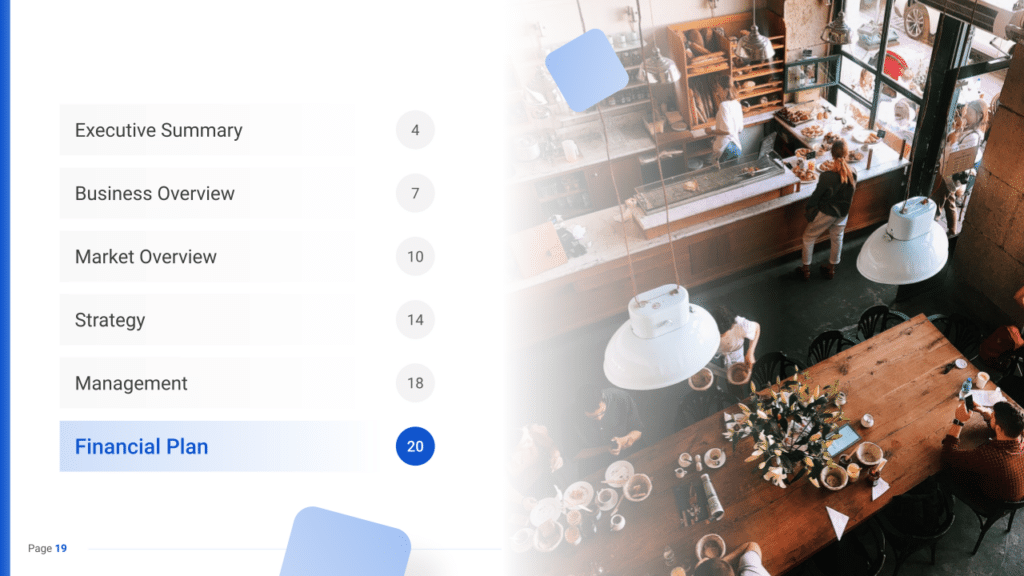
Privacy Overview

Item added to your cart
How to write a business plan for your restaurant.

Starting a restaurant can be a great way to make a living while also providing a valuable service to the community.
It can also be a great way to express creativity, as a restaurant provides an opportunity to create unique dishes and experiences for customers.
Nevertheless, the first step is to develop a business plan.
A business plan is essential before starting a new project such as a restaurant. It should include a detailed description of the business, a marketing plan, and a financial plan. A business plan helps ensure that the project is well-planned and organized, and will help set the project up for success.
In short, a thorough business plan will help make sure your restaurant is profitable .
What should be covered when creating a business plan for a restaurant? How can it be presented clearly? What financial metrics should be included? How can I develop an efficient business plan in less time?
Exciting news! The forthcoming article holds all the answers to these questions!
Also, please note that starting your business plan from scratch is not mandatory.
Instead, you can download our professional business plan for a restaurant and tailor it to suit your requirements.

How to develop a business plan for a restaurant
Is a business plan recommended for your restaurant.
Yes, you should create a business plan for your restaurant.
Formulating a comprehensive business plan will allow to:
- get familiar with the restaurant market
- keep up with the industry's changing trends
- establish what makes a restaurant competitive
- understand what your consumers want to eat
- come up with a great value proposition for your dining establishment
- identify competitive advantages and disadvantages
- find distinctive competitive edges for your restaurant
- find a business model that ensures a sustainable profit margin
- formulate an effective strategy to drive business growth
- evaluate potential risks associated with operating a restaurant, such as foodborne illnesses, customer satisfaction, and staff turnover
Our team has drafted a business plan for a restaurant that is designed to make it easier for you to achieve all the elements listed.
How to organize a business plan for a restaurant?
A meticulously written business plan provides all the necessary information, numbers, and financial details. It must be presented in a structured format, to make easy to read and digest.
When we built our business plan for a restaurant , we made sure to set it up correctly.
We've divided it into 5 sections (Opportunity, Project, Market Research, Strategy and Finances).
1. Market Opportunity
The section number one is designated as "Market Opportunity."
This section presents a comprehensive report on the restaurant industry, including key data and metrics to guide your decision-making process in the food service sector.
We renew this section twice a year for up-to-date data.
2. Project Presentation
The "Project" section allows you to present your pottery studio project, including the available pottery techniques, studio layout, classes offered, and highlight the unique value proposition for pottery enthusiasts.
At the end of this section, provide a brief introduction about yourself and your culinary journey.
Explain your culinary style, your commitment to using quality ingredients, and how you plan to create a memorable dining experience for guests at your restaurant. Highlight your menu offerings, your skilled kitchen and waitstaff, and your dedication to providing exceptional customer service that ensures guests have a delightful and satisfying culinary experience at your restaurant.
In our business plan, you'll find that we've given you pre-existing content. Modify it to match your idea exactly.
3. Market Research
After that, comes the "Market Research" section.
The purpose of this section is to introduce the market segments for your restaurant.
It includes a competition study, outlining similar restaurants in the area. Your restaurant's competitive advantages are also highlighted. A customized SWOT analysis is included.
4. Strategy
Within the "Strategy" section, a 3-year development plan is outlined, specifying the necessary initiatives to make your restaurant highly profitable.
Moreover, you will find a marketing strategy, a risk management approach, and a Business Model Canvas specifically designed for a restaurant in this section.
5. Finances
Lastly, the "Finances" section is dedicated to illustrating the financial plan and data for your project.

How to make an Executive Summary for a restaurant?
The Executive Summary can be seen as a condensed overview of the business plan for your restaurant.
Keep it brief and focused, with a maximum of 2 pages. Include only the key elements.
It's the first thing an investor will read when you share your business plan with them. It should catch their interest and make them want to read the rest of the plan.
In the Executive Summary of your restaurant, provide answers to these questions: what type of cuisine does your restaurant offer? who is your target audience? are there other restaurants in the area? what makes your restaurant special? how much funding do you require?
How to do the market analysis for a restaurant?
Analyzing the market for your restaurant allows you to gain insights into factors such as customer preferences for dining experiences, competition within the food service industry, and emerging trends in culinary innovation.
By conducting a comprehensive market analysis, a restaurant can understand customer preferences, offer a diverse and delicious menu, optimize pricing strategies, and execute targeted marketing campaigns, ultimately leading to a loyal customer base, increased reservations, and a prominent position in the local dining scene.
Here's what we've included in the "Market Research" section of our business plan for a restaurant :
- recent data and statistics about the restaurant industry, including customer dining preferences, revenue trends, and popular cuisine choices
- a list of potential market segments for a restaurant
- the competitor study
- the potential competitive advantages for a restaurant

The key points of the business plan for a restaurant
What's the business model of a restaurant, business model of a restaurant.
A restaurant's business model centers around offering a menu of food and beverages for dine-in, takeout, or delivery services. Revenue is generated through food sales, potentially offering additional services such as catering or private events.
The business model focuses on creating a diverse and appealing menu, delivering excellent food quality and taste, providing exceptional customer service, effective marketing to target food lovers, and building strong customer relationships based on taste and dining experience.
Success depends on recipe innovation, maintaining consistent food quality, delivering efficient service, fostering positive customer reviews and recommendations, and creating a welcoming and comfortable restaurant ambiance that attracts a loyal customer base.
Business model vs Business plan
Don't get "business plan" and "business model" mixed up.
A business model outlines the way a company creates value, generates revenue, and operates.
In a business plan, you demonstrate your business model using a structure called the Business Model Canvas.
And, of course, there is a Business Model Canvas (already completed) in our business plan for a restaurant .
How do you identify the market segments of a restaurant?
Market segmentation for your recruitment agency business involves dividing your potential clients into different groups based on their hiring needs, industries, and preferences.
These categories may include factors such as IT recruitment, healthcare recruitment, executive search, or clients seeking specific recruitment services (e.g., temporary staffing, talent acquisition, niche specialization).
By segmenting your market, you can offer specialized recruitment services and solutions that cater to each segment's specific requirements. For example, you might focus on IT recruitment and provide sourcing and placement services for tech companies or startups, offer comprehensive healthcare recruitment services and assist hospitals, clinics, or healthcare organizations in finding qualified medical professionals, specialize in executive search and help businesses identify top-tier executive talent, or focus on specific recruitment services such as temporary staffing for companies in need of short-term staffing solutions or niche specialization to serve a specific industry or job market.
Market segmentation allows you to effectively target your marketing efforts, communicate your expertise in specific industries or recruitment services, and provide reliable and efficient recruitment solutions that meet the unique needs and preferences of each client segment.
In the business plan for a restaurant , you will find a comprehensive market segmentation that will help you identify your potential customers.
How to conduct a competitor analysis for a restaurant?
It's clear that you won't be the only restaurant in your city. There are other dining establishments offering diverse cuisines and culinary experiences to patrons.
Make sure to thoroughly analyze your competitors as part of your business plan by listing their attributes, strengths, and weaknesses.
Address their weaknesses (such as inconsistent food quality, slow service, or poor cleanliness).
Why is it important to address these concerns? Because these weaknesses can impact the dining experience at restaurants.
By focusing on these areas, you can provide a diverse and delicious menu, offer excellent customer service, and create an inviting and memorable ambiance, establishing your restaurant as a go-to choice for dining out and enjoying great food.
It's what we call competitive advantages—invest in them to make your business unique.
Here are some examples of competitive advantages for a restaurant: delectable and diverse menu offerings, exceptional culinary skills, inviting and stylish ambiance, efficient service, outstanding customer reviews and reputation, excellent hygiene and cleanliness, accommodating for special dietary needs or preferences.
How to draft a SWOT analysis for an eatery?
A SWOT analysis can help identify strengths, weaknesses, opportunities, and threats associated with starting a restaurant, allowing for informed decision-making.
As you can guess, there is indeed a completed and editable SWOT matrix in our business plan for a restaurant
The strengths for a restaurant
When we use the "S" in SWOT, we're talking about Strengths, which are the project's strong points.
For a restaurant, possible strengths could include friendly staff, great food, a good atmosphere, and competitive prices.
The weaknesses for a restaurant
The "W" represents Weaknesses, indicating the areas or aspects of the project that need enhancement.
For a restaurant, potential weaknesses could include a lack of online presence, insufficient staffing, limited menu options, and inadequate customer service.
The opportunities for a restaurant
When we use the "O" in SWOT, we're talking about Opportunities, which are the external possibilities or favorable situations for the project.
In the case of a restaurant, potential opportunities include expanding the catering business, introducing new menu items, developing a loyalty program, and offering delivery services.
The threats for a restaurant
T represents Threats, which are the external factors or circumstances that can pose risks or hindrances to the project's progress.
How to elaborate a marketing strategy for an eatery?
A marketing strategy is a key factor in acquiring customers and increasing revenue, so include it in your business plan.
Developing an effective marketing approach will help your restaurant connect with food enthusiasts seeking a unique and delectable dining experience.
Diners won't choose your restaurant without effective promotion; emphasizing the culinary experience, ambiance, and unique offerings is necessary.
Have you explored marketing approaches to attract customers to your restaurant? Consider creating mouthwatering food photography for social media, hosting themed events or special menus, and collaborating with food bloggers or influencers for reviews.
Don't panic if you lack knowledge about marketing and communication – there are resources to help you learn.
How to build a solid financial plan for an eatery?
A successful business plan requires comprehensive financial data in order to accurately forecast future performance.
In your business plan, you will have to make revenue projections for your restaurant.
We must ensure that this revenue forecast is reasonable and easily comprehensible.
Our financial plan for a restaurant is user-friendly, providing automated validations that allow you to rectify any assumptions swiftly. This guarantees the creation of credible projections with ease and assurance.
Naturally, you'll have to prepare an initial budget for your restaurant. Don't forget any expense (we have listed them all in our financial plan !).
The break-even analysis is a crucial tool in your financial plan, providing insight into whether your restaurant will be profitable or not.
- Choosing a selection results in a full page refresh.
- Opens in a new window.

Internet Cafe Business Plan Template
Written by Dave Lavinsky
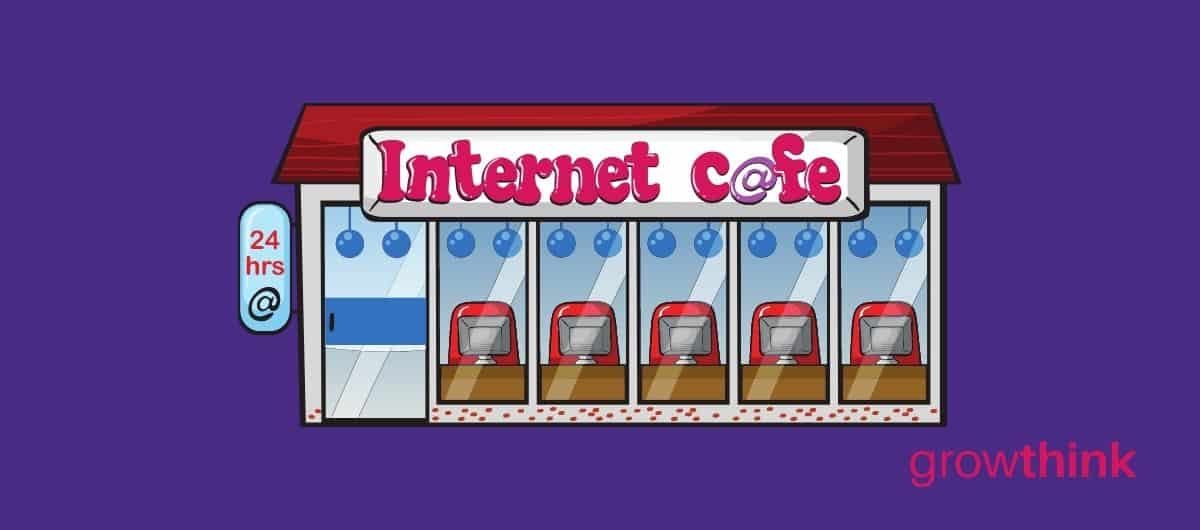
Internet Cafe Business Plan
Over the past 20+ years, we have helped over 500 entrepreneurs and business owners create business plans to start and grow their internet cafe companies.
If you’re unfamiliar with creating an internet cafe business plan, you may think creating one will be a time-consuming and frustrating process. For most entrepreneurs it is, but for you, it won’t be since we’re here to help. We have the experience, resources, and knowledge to help you create a great business plan.
In this article, you will learn some background information on why business planning is important. Then, you will learn how to write an internet cafe business plan step-by-step so you can create your plan today.
Download our Ultimate Business Plan Template here >
What is an Internet Cafe Business Plan?
A business plan provides a snapshot of your internet cafe business as it stands today, and lays out your growth plan for the next five years. It explains your business goals and your strategies for reaching them. It also includes market research to support your plans.
Why You Need a Business Plan for an Internet Cafe
If you’re looking to start an internet cafe business or grow your existing internet cafe company, you need a business plan. A business plan will help you raise funding, if needed, and plan out the growth of your internet cafe business to improve your chances of success. Your internet cafe business plan is a living document that should be updated annually as your company grows and changes.
Sources of Funding for Internet Cafe Businesses
With regards to funding, the main sources of funding for an internet cafe business are personal savings, credit cards, bank loans, and angel investors. When it comes to bank loans, banks will want to review your business plan and gain confidence that you will be able to repay your loan and interest. To acquire this confidence, the loan officer will not only want to ensure that your financials are reasonable, but they will also want to see a professional plan. Such a plan will give them the confidence that you can successfully and professionally operate a business. Personal savings and bank loans are the most common funding paths for internet cafe companies.
Finish Your Business Plan Today!
How to write a business plan for an internet cafe business.
If you want to start an internet cafe business or expand your current one, you need a business plan. The guide below details the necessary information for how to write each essential component of your internet cafe business plan.
Executive Summary
Your executive summary provides an introduction to your business plan, but it is normally the last section you write because it provides a summary of each key section of your plan.
The goal of your executive summary is to quickly engage the reader. Explain to them the kind of internet cafe business you are running and the status. For example, are you a startup, do you have an internet cafe business that you would like to grow, or are you operating a chain of internet cafe businesses?
Next, provide an overview of each of the subsequent sections of your plan.
- Give a brief overview of the internet cafe industry.
- Discuss the type of internet cafe business you are operating.
- Detail your direct competitors. Give an overview of your target customers.
- Provide a snapshot of your marketing strategy. Identify the key members of your team.
- Offer an overview of your financial plan.
Company Overview
In your company overview, you will detail the type of internet cafe business you are operating.
For example, you might specialize in one of the following types of internet cafe businesses:
- Internet kiosks : In this type of internet cafe business, small kiosks are built and positioned to be temporary internet cafes, as customers who visit the kiosks search the internet for directions, locations and other information.
- Cyber cafe: A cyber cafe is similar to an internet cafe, although the usage of the internet may be mixed with gaming and internet searches.
- Gaming cafe: Popular with teens, a gaming cafe offers computers and gaming accessories connected to very high bandwidth, which allows for specialized gaming.
- Commercial cafe: These internet cafes exist to serve commercial establishments with a need for high bandwidth and dedicated spaces.
In addition to explaining the type of internet cafe business you will operate, the company overview needs to provide background on the business.
Include answers to questions such as:
- When and why did you start the business?
- What milestones have you achieved to date? Milestones could include the number of customers served, the number of commercial contracts on file, or reaching X number of return gamers served, etc.
- Your legal business Are you incorporated as an S-Corp? An LLC? A sole proprietorship? Explain your legal structure here.
Industry Analysis
In your industry or market analysis, you need to provide an overview of the internet cafe industry.
While this may seem unnecessary, it serves multiple purposes.
First, researching the internet cafe industry educates you. It helps you understand the market in which you are operating.
Secondly, market research can improve your marketing strategy, particularly if your analysis identifies market trends.
The third reason is to prove to readers that you are an expert in your industry. By conducting the research and presenting it in your plan, you achieve just that.
The following questions should be answered in the industry analysis section of your internet cafe business plan:
- How big is the internet cafe industry (in dollars)?
- Is the market declining or increasing?
- Who are the key competitors in the market?
- Who are the key suppliers in the market?
- What trends are affecting the industry?
- What is the industry’s growth forecast over the next 5 – 10 years?
- What is the relevant market size? That is, how big is the potential target market for your internet cafe business? You can extrapolate such a figure by assessing the size of the market in the entire country and then applying that figure to your local population.
Customer Analysis
The customer analysis section of your internet cafe business plan must detail the customers you serve and/or expect to serve.
The following are examples of customer segments: individuals, gamer groups, and corporations.
As you can imagine, the customer segment(s) you choose will have a great impact on the type of internet cafe business you operate. Clearly, individuals would respond to different marketing promotions than corporations, for example.
Try to break out your target customers in terms of their demographic and psychographic profiles. With regards to demographics, including a discussion of the ages, genders, locations, and income levels of the potential customers you seek to serve.
Psychographic profiles explain the wants and needs of your target customers. The more you can recognize and define these needs, the better you will do in attracting and retaining your customers.
Finish Your Internet Cafe Business Plan in 1 Day!
Don’t you wish there was a faster, easier way to finish your business plan?
With Growthink’s Ultimate Business Plan Template you can finish your plan in just 8 hours or less!
Competitive Analysis
Your competitive analysis should identify the indirect and direct competitors your business faces and then focus on the latter.
Direct competitors are other internet cafe businesses.
Indirect competitors are other options that customers have to purchase from that aren’t directly competing with your product or service. This includes private homes with high bandwidth internet services, video game lounges, and gaming casinos. You need to mention direct competition, as well.
For each direct competitor, provide an overview of their business and document their strengths and weaknesses. Unless you once worked at your competitors’ businesses, it will be impossible to know everything about them. But you should be able to find out key things about them such as
- What types of customers do they serve?
- What type of internet cafe business are they?
- What is their pricing (premium, low, etc.)?
- What are they good at?
- What are their weaknesses?
With regards to the last two questions, think about your answers from the customers’ perspective. And don’t be afraid to ask your competitors’ customers what they like most and least about them.
The final part of your competitive analysis section is to document your areas of competitive advantage. For example:
- Will you provide options for multiple rounds of gaming play?
- Will you offer internet services that your competition doesn’t?
- Will you provide snacks and other amenities?
- Will you offer better pricing?
Think about ways you will outperform your competition and document them in this section of your plan.
Marketing Plan
Traditionally, a marketing plan includes the four P’s: Product, Price, Place, and Promotion. For a internet cafe business plan, your marketing strategy should include the following:
Product : In the product section, you should reiterate the type of internet cafe company that you documented in your company overview. Then, detail the specific products or services you will be offering. For example, will you provide an internet cafe that serves light snacks and meals, along with a gaming lounge area?
Price : Document the prices you will offer and how they compare to your competitors. Essentially in the product and price sub-sections of your plan, you are presenting the products and/or services you offer and their prices.
Place : Place refers to the site of your internet cafe company. Document where your company is situated and mention how the site will impact your success. For example, is your internet cafe business located in a busy retail district, a neighborhood strip mall, or a standalone building near a college? Discuss how your site might be the ideal location for your customers.
Promotions : The final part of your internet cafe marketing plan is where you will document how you will drive potential customers to your location(s). The following are some promotional methods you might consider:
- Advertise on radio stations and/or gaming magazines
- Reach out to websites
- Distribute flyers to card collector and game stores
- Engage in email marketing
- Advertise on social media platforms
- Improve the SEO (search engine optimization) on your website for targeted keywords
Operations Plan
While the earlier sections of your business plan explained your goals, your operations plan describes how you will meet them. Your operations plan should have two distinct sections as follows.
Everyday short-term processes include all of the tasks involved in running your internet cafe business, including setting up game play for groups, planning and providing internet sessions, billing customers, etc.
Long-term goals are the milestones you hope to achieve. These could include the dates when you expect to book your Xth gaming session, or when you hope to reach $X in revenue. It could also be when you expect to expand your internet cafe business to a new city.
Management Team
To demonstrate your internet cafe business’ potential to succeed, a strong management team is essential. Highlight your key players’ backgrounds, emphasizing those skills and experiences that prove their ability to grow a company.
Ideally, you and/or your team members have direct experience in managing internet cafe businesses. If so, highlight this experience and expertise. But also highlight any experience that you think will help your business succeed.
If your team is lacking, consider assembling an advisory board. An advisory board would include 2 to 8 individuals who would act as mentors to your business. They would help answer questions and provide strategic guidance. If needed, look for advisory board members with experience in managing an internet cafe business or successfully running a card and game store.
Financial Plan
Your financial plan should include your 5-year financial statement broken out both monthly or quarterly for the first year and then annually. Your financial statements include your income statement, balance sheet, and cash flow statements.
Income Statement
An income statement is more commonly called a Profit and Loss statement or P&L. It shows your revenue and then subtracts your costs to show whether you turned a profit or not.
In developing your income statement, you need to devise assumptions. For example, will you see 30 internet customers per day, and/or offer group gaming sessions? And will sales grow by 2% or 10% per year? As you can imagine, your choice of assumptions will greatly impact the financial forecasts for your business. As much as possible, conduct research to try to root your assumptions in reality.
Balance Sheets
Balance sheets show your assets and liabilities. While balance sheets can include much information, try to simplify them to the key items you need to know about. For instance, if you spend $50,000 on building out your internet cafe business, this will not give you immediate profits. Rather it is an asset that will hopefully help you generate profits for years to come. Likewise, if a lender writes you a check for $50,000, you don’t need to pay it back immediately. Rather, that is a liability you will pay back over time.
Cash Flow Statement
Your cash flow statement will help determine how much money you need to start or grow your business, and ensure you never run out of money. What most entrepreneurs and business owners don’t realize is that you can turn a profit but run out of money and go bankrupt.
When creating your Income Statement and Balance Sheets be sure to include several of the key costs needed in starting or growing a internet cafe business:
- Cost of equipment and accessories
- Payroll or salaries paid to staff
- Business insurance
- Other start-up expenses (if you’re a new business) like legal expenses, permits, computer software, internet bandwidth, office supplies
Attach your full financial projections in the appendix of your plan along with any supporting documents that make your plan more compelling. For example, you might include your multi-year contract for internet services or your location lease.
Writing a business plan for your internet cafe business is a worthwhile endeavor. If you follow the template above, by the time you are done, you will truly be an expert. You will understand the internet cafe industry, your competition, and your customers. You will develop a marketing strategy and will understand what it takes to launch and grow a successful internet cafe business.
Internet Cafe Business Plan FAQs
What is the easiest way to complete my internet cafe business plan.
Growthink's Ultimate Business Plan Template allows you to quickly and easily write your internet cafe business plan.
How Do You Start an Internet Cafe Business?
Starting an Internet Cafe business is easy with these 14 steps:
- Choose the Name for Your Internet Cafe Business
- Create Your Internet Cafe Business Plan
- Choose the Legal Structure for Your Internet Cafe Business
- Secure Startup Funding for Your Internet Cafe Business (If Needed)
- Secure a Location for Your Business
- Register Your Internet Cafe Business with the IRS
- Open a Business Bank Account
- Get a Business Credit Card
- Get the Required Business Licenses and Permits
- Get Business Insurance for Your Internet Cafe Business
- Buy or Lease the Right Internet Cafe Business Equipment
- Develop Your Internet Cafe Business Marketing Materials
- Purchase and Setup the Software Needed to Run Your Internet Cafe Business
- Open for Business
Where Can I Download a Free Business Plan Template PDF?
Click here to download the pdf version of our basic business plan template.
Our free business plan template pdf allows you to see the key sections to complete in your plan and the key questions that each must answer. The business plan pdf will definitely get you started in the right direction.
We do offer a premium version of our business plan template. Click here to learn more about it. The premium version includes numerous features allowing you to quickly and easily create a professional business plan. Its most touted feature is its financial projections template which allows you to simply enter your estimated sales and growth rates, and it automatically calculates your complete five-year financial projections including income statements, balance sheets, and cash flow statements. Here’s the link to our Ultimate Business Plan Template.
Don’t you wish there was a faster, easier way to finish your Internet Cafe business plan?
OR, Let Us Develop Your Plan For You
Since 1999, Growthink has developed business plans for thousands of companies who have gone on to achieve tremendous success. Click here to see how Growthink’s business plan services can give you a winning business plan.
Other Helpful Business Plan Articles & Templates


Starting an Internet Cafe Business Plan (PDF)

We are living in a digital age where access to the internet and social media are no longer a luxury. That is why the internet café business is a lucrative business to start today. An internet café is a shop designed to primarily provide fast, reliable, and safe internet access to customers and other related services like printing. Internet cafes can also be called cyber cafes. The importance of internet cafes is apparent. There are many people who do not have what it takes to set up internet connectivity at their homes. Such people get to participate in the digital economy via the use of internet café services.
Operating an internet cafe business is a lucrative and profitable venture. The internet cafe has become the go-to place for people who wish to do their surfing and administrative work without having to go home. For some corporate types, it is a lunchtime pastime where they can surf without facing the scrutiny of their employers. The internet cafe offers a very good gateway for people with limited capital and an ambition to do business in technology. All the positive things about an internet cafe business do not diminish its demands and specifications. You have to be on point in terms of your customer care. Good understanding of the business is a must, otherwise you will be swallowed up by the competition. This article will outline how to start the internet cafe business, and the internet cafe business plan – PDF, Word & Excel.
Market Research
Conducting a market research for your internet café business is imperative. You will get to study your intended target market to see if there is need for an internet café. You will have to check to see if there are any already existing internet cafes. If there are, these will be invaluable case studies from which to draw essential insights. Taking time to visit them and use their services will give you a feel of the market. Your market research can also involve looking through current statistics and trends regarding internet access. You have to take this market research seriously because if you do not, you might regret later.
Location And Premises
You should select locations that are well within the vicinity of your potential clients. For example, you may locate your internet cafe business in shopping centers & malls, near offices, schools, universities and airports. This is where the clientele is likely to come from so you are in the best position to gain access to them. Test the internet quality because nobody is going to pay for anything less than full-time high speed services. Good internet is both fast and reliable. It is never a good idea to congregate with other internet cafes. That essentially means that you are inviting competitors to take away your potential customers. You need a good power source and a backup generator. In the age of green technology, try to make use of energy savings when operating your internet cafe business. For example, the use of solar power in hot climates is ideal.
The internet cafe space can be leased or bought. The advantage of leasing is that you are not saddled with a mortgage. If you want to move your internet cafe business for any reason, it is merely a case of giving notice at the end of the month. Moreover, not having a mortgage reduces your initial capital requirements. The money that would have been spent on purchasing an office space could be distributed between leasing and other essential business expenses. Meanwhile the companies that let out office space tend to provide a number of important peripheral services. These include a post office box, administrative support, toilets and a cafeteria. That means that you can give your customers a very rich experience and convenience without spending too much money on it. The costs of purchasing or leasing the premises should be included in the internet cafe business plan.
Permits/Licenses, Insurance & Business Bank Account
Company registration and relevant licenses.
To be a recognized internet café business you must register it first. This refers to your basic business or company registration. Then you are usually obligated to get an operating license for your internet café shop. Maybe you could be renting it, buying it, or building it; an operating license will be needed. Depending on the nature of your internet café services, there might software licenses you must get. It is common practice for people to use bootlegged software. However, it would be wise to use only properly licensed software in your internet café.
Insurance & Business Bank Account
The internet café business is usually characterized by costly infrastructure, furniture, and gadgets. The value of these items necessitates the importance of getting insurance cover. There are many possible incidents that can occur so getting insured is prudent. Your internet café operations must have their own business bank account. This makes financial management easier. Plus you protect yourself from being personally liable if things go south. That separation protects your personal finances and assets.
Equipment, Products & Services
You need computers and internet routers for your internet cafe business. An internet cafe can have anywhere between two and an large number of computers. The number of computers to buy depend on the size of the premises, your budget, and your target market. You might consider including some peripheral items such as a scanner, printer, photocopier, binder and facsimile. These are services that might be of benefit to the people that come to your internet cafe. In effect you are enriching their experiences at your establishment without requiring them to travel somewhere else. The primary service for an internet cafe is internet surfing & browsing. The other services that you can offer in your internet cafe include printing, photocopying, binding, typing, lamination, selling computer accessories, snacks and beverages. If you are selling drinks & refreshments that means you will require a refrigerator. It’s also wise to offer gaming in your internet cafe as that attracts a lot of young customers. Your internet should be fast and reliable – so take your time when selecting an internet service provider. This is key to the success of an internet cafe business. The cyber cafe business plan should include the costs of purchasing the equipment that you require.
Depending on the level of activity, you may want to have an electronic ticketing and point of sale system. This ensures that there are no long queues for service with people complaining that they have been overlooked. Some cyber cafes even use a bar-code scanner. This way, they can audit every single product that is sold. The normal unit of measurement for internet services is the amount of time that the user spends. You can use other methods such as a token system. Do not forget to install some air-conditioning. The equipment is bound to heat up considerably in such a confined space, with such heavy-duty usage. Inevitably you may have to hire a technician to configure and maintain the different computers. It is likely that there will be issues from time to time which require professional attention.
Business Model
Charging customers for internet access.
The internet café business model is simple straightforward. Customers come to pay to access the internet. This is often based on charges per 30 minutes or an hour. There can be discounted rates when someone pays for a substantial number of hours. There is also an approach where a client opens up an account which they can load up with credit. That way they can come in several times to access the internet. Once the credit is used up they can load more and so forth. Another different approach is that a client pays for data instead of a time slot. This means they get to purchase a certain amount of data e.g. 15 gigabytes. The data can have an expiration time or date or it can be carried over to the next time they log in. This shows you that there are many ways to use in revenue generation pertaining to internet access.
Adding On Monetizable Related Products Or Services
When running an internet café you can also make lots more money from other products or services. For instance, you can include computer repairs and sale of parts or accessories. You can also venture into mobile device and accessory sales and repairs. You can include a gaming arcade for all sorts of games. You can include vending machines or general sales of refreshments. You could provide on-demand services such as typing, printing, and photocopying, amongst others. Another revenue generator can be providing a co-working space. Depending on the size of your location you can rent work space, work desks, or rooms. These are just some of the many ways to make money running an internet café. It is unwise to solely just focus on providing internet access services.
Rules and Regulations For Internet Cafe Business
You will need to set out the terms of service which are publicly available. For example, some internet cafes do not allow the consumption of food and drinks. Others place restrictions on the content that can be searched, processed and downloaded. The state will also take an interest in internet activity and you may therefore be asked to maintain records. These rules may temporarily inconvenience some of your customers. However, they are essential in order to ensure that the entire process runs smoothly and that you do not get into trouble with the regulators.
Some cyber cafe business owners take preventative measures by warning their prospective clients about the rules. They also install a monitoring system that will tell them when things are going wrong. Beware that there are some clients that will want to take advantage of a weak system. For example, they may do all their office downloads in the cafe whilst restricting the payments that they make. This means that your bandwidth is facing pressure and yet you are not getting paid for it.
Staff and Management
The number of employees required depends on the size of your internet cafe. This is not a labour intensive business. At the minimum you need internet cafe assistants. Their job include:
- Welcoming customers, serving them and collecting payments
- Help customers with the use of computer software or any challenges they might face
- Maintaining cleanliness in the internet cafe
- Provide services such as printing, photocopying, scanning etc.
- Monitor use of computers to ensure compliance with internet café policies and applicable laws and regulation
Other staff positions include manager, IT Technician, finance & accounting staff, sales & marketing staff, though most of those can be done by one person for a small internet cafe business. The cyber cafe business plan should cater for the salaries of all your employees.
Marketing Plan
An internet café business has two broad set of potential customers. There are people who are unfamiliar with using the internet. Then there are people who are substantially familiar with the internet. Your marketing efforts seek to lure both sets of prospects. Breaking it down further you will be targeting students, business people, entrepreneurs, and random people. Create and spread out your digital footprint by putting up a website and social media accounts. Propagate promotional material in print and other electronic media. Good examples of these are radio, television, podcasts, skits, and newspapers. You can also participate in or contribute to strategic events where your target pools will be there. Put up posters and banners inside and outside the internet café.
The market for internet services is huge world-wide. More and more people are using the internet daily. Potential customers for an internet cafe include students, gamers, job seekers, business people, freelancers and professionals from various fields. It’s essential that you offer fast internet so as to attract more customers. Your employees should be knowledgeable and friendly. A proper marketing strategy should be included in your internet cafe business plan. This is one of the least capital intensive businesses. The internet cafe business is a huge income earner for individual entrepreneurs. It also employs countless numbers of people in the developing world. The internet cafe business is particularly lucrative in the developing world. This is because many people have some knowledge of the internet but are not rich enough to purchase their own personal computer for home use.
Keys To Profitability
Offer discounts for heavy internet users. Provide an account-based internet access for repeat customers. These two elements put together build customer loyalty. This is the kind of loyalty that promotes word of mouth and results in referrals. Ensure your computers or gadgets in general, are up to standard all the time. Ensuring the internet speed is fast and reliable is pertinent. Couple that with fast processing and reliable gadgets as well. That will keep customers coming back to your internet café. Diversify your revenue by offering as many services as you can. This is the most important key in increasing your profits. You internet café must go beyond by offering additional products and services. That is how you get to start a profitable internet café business. It is worth reiterating that market research must be thorough here. This also implies that your choice of location will be paramount. The internet café business can be quite lucrative. You just have to ensure you have a sustainable market for it.
Pre-Written Internet Cafe Business Plan (PDF, Word And Excel): Comprehensive Version, Short Funding/Bank Loan Version and Automated Financial Statements
For an in-depth analysis of the internet cafe business, we encourage you to purchase our well-researched and comprehensive internet cafe business plan. We introduced the business plans after discovering that many were venturing into the internet cafe business without enough knowledge and understanding of how to run the business, lack of understanding of the financial side of the business, lack of understanding of : the industry, the risks involved , costs and profitability of the business; which often leads to disastrous losses.
The StartupBiz Global internet cafe business plan will make it easier for you to launch and run your internet cafe business successfully, fully knowing what you are going into, and what’s needed to succeed in the business. This is a complete business plan for an internet cafe business. It will be easier to plan and budget as you will be aware of all the costs involved in setting up and running the internet cafe business.
Uses of the Internet Cafe Business Plan (PDF, Word And Excel)
The cyber cafe business plan can be used for many purposes including:
- Raising capital from investors/friends/relatives
- Applying for a bank loan
- Start-up guide to launch your internet cafe business
- As an internet cafe business proposal
- Assessing profitability of the internet cafe business
- Finding a business partner
- Assessing the initial start-up costs so that you know how much to save
- Manual for current business owners to help in business and strategy formulation
Contents of the Internet Cafe Business Plan (PDF, Word And Excel)
The business plan for an internet cafe includes, but not limited to:
- Marketing Strategy
- Financial Statements (monthly cash flow projections, income statements, cash flow statements, balance sheets, break even analysis, payback period analysis, start-up costs, financial graphs, revenue and expenses, Bank Loan Amortization)
- Industry Analysis
- Market Analysis
- Risk Analysis
- SWOT & PEST Analysis
- Operational Requirements
- Operational Strategy
- Why some people in the internet cafe business fail, so that you can avoid their mistakes
- Ways to raise capital to start your internet cafe business
The internet cafe business plan package consists of 4 files
- Internet Cafe Business Plan – PDF file (Comprehensive Version – 74 Pages)
- Internet Cafe Business Plan – Editable Word File (Comprehensive Version – 74 Pages)
- Internet Cafe Business Plan Funding/Bank Loan Version- Editable Word File (Short version for applying for a loan/funding – 41 pages)
- Internet Cafe Business Plan Automated Financial Statements – (Editable Excel File)
The business plan can be used in any country and can be easily edited. The financial statements are automated. This implies that you can change eg the costs, salaries etc, and all the other financial statements will automatically adjust to reflect the change.
Click below to download the Contents Page of the Internet Cafe Business Plan (PDF)

Testimonial 2
Many thanks for your incredibly efficient service and thorough business plan. I am very impressed with the business plan. Before I bought the business plan, I tried to do my own business plan – it was such a nightmare and it turned out badly, also not to mention the stress it caused me. I wish I knew about your website earlier!
Testimonial 7
I found Startupbiz Global online when I was in desperate need of a business plan. I was overwhelmed by the quality of the business plan, it’s comprehensive and well researched! I did not have to wait to get the business plan, I got it instantly after payment. I highly recommend Startupbiz Global, and would happily use them again in the future.
Testimonial 3
I was extremely lucky to come across StartupBiz Global. Their business plan exceeded my expectations, and most importantly I was able to secure a loan from my bank. Thank you guys, now my dreams are coming true!
Testimonial 6
I purchased a business plan from you, and I’m glad to inform you that I was able to get my loan, and I’m starting my poultry farming business on the 1 st of July. This was made possible because of your business plan. Thank you very much, you made my dream come true.
Testimonial 4
The business plan which I purchased from your website saved me TIME and MONEY! The layout of the business plan was excellent. The financial statements were detailed and easy for me to edit. I will come back to purchase another business plan soon.
Testimonial 5
I was able to understand the business side of farming because of your business plan. You did extensive research; the business plan was well prepared and fully detailed. It made everything clear, and I have somewhere to start now. I am confident that I am going to succeed in my business because of the guidance from your business plan.
Testimonial 1
StartupBiz Global provided a very professional and comprehensive business plan which I used for my business. The business plan was easy to edit, and I was able to get the funding which I wanted. I highly recommend their business plans.
Testimonial 8
Just wanted to say I am very happy with the business plan and I will gladly recommend your products, thank you very much and have a great day.
Get the Internet Cafe Business Plan (PDF, Word And Excel)
Click Buy Now below to purchase using Paypal, Credit Card, or Debit Card. After you have purchased, you will immediately see the download link for the business plan package on the screen. You will also immediately get an email with the business plan download link. The Pre-written business plan package (PDF, Word, and Excel) costs $30 only!

If you want to purchase multiple business plans at once then click here: Business Plans Store.
The business plan package is a zipped compressed file containing the PDF, Word and Excel documents. To open the package after downloading it, just right click, and select Extract All. If you have any problems in downloading and opening the files, email us on [email protected] and we will assist you.
We wish you the best in your internet cafe business! Check out our collection of business plans , and more business ideas .
Related Posts

How To Start An Uber Drivers Business

Starting Cleaning Services Business Plan (PDF)

Starting Tyre Fitment Centre Business Plan (PDF)

Starting Goat Farming Business Plan (PDF)

Join our mailing list to receive the latest posts and updates from our website.
You have Successfully Subscribed!
What caused Dubai floods? Experts cite climate change, not cloud seeding
- Medium Text
DID CLOUD SEEDING CAUSE THE STORM?

CAN'T CREATE CLOUDS FROM NOTHING
Coming soon: Get the latest news and expert analysis about the state of the global economy with Reuters Econ World. Sign up here.
Reporting by Alexander Cornwell; editing by Maha El Dahan and Alexandra Hudson
Our Standards: The Thomson Reuters Trust Principles. New Tab , opens new tab
Hong Kong-based shipping company Wah Kwong is finalising a deal later this month to double the number of liquefied natural gas (LNG) carriers that it has ordered to four, as it eyes growing global trade in the superchilled fuel, its chairman said.

World Chevron
North Korea fired a ballistic missile on Monday towards the sea off its east coast, South Korea's military said.


Free Download
Coffee Shop Business Plan Template
Download this free coffee shop business plan template, with pre-filled examples, to create your own plan..
Or plan with professional support in LivePlan. Save 50% today
Available formats:
What you get with this template
A complete business plan.
Text and financials are already filled out and ready for you to update.
- SBA-lender approved format
Your plan is formatted the way lenders and investors expect.
Edit to your needs
Download as a Word document and edit your business plan right away.
- Detailed instructions
Features clear and simple instructions from expert business plan writers.
All 100% free. We're here to help you succeed in business, no strings attached.
Get the most out of your business plan example
Follow these tips to quickly develop a working business plan from this sample.
1. Don't worry about finding an exact match
We have over 550 sample business plan templates . So, make sure the plan is a close match, but don't get hung up on the details.
Your business is unique and will differ from any example or template you come across. So, use this example as a starting point and customize it to your needs.
2. Remember it's just an example
Our sample business plans are examples of what one business owner did. That doesn't make them perfect or require you to cram your business idea to fit the plan structure.
Use the information, financials, and formatting for inspiration. It will speed up and guide the plan writing process.
3. Know why you're writing a business plan
To create a plan that fits your needs , you need to know what you intend to do with it.
Are you planning to use your plan to apply for a loan or pitch to investors? Then it's worth following the format from your chosen sample plan to ensure you cover all necessary information.
But, if you don't plan to share your plan with anyone outside of your business—you likely don't need everything.
More business planning resources

How to Start a Coffee Shop Business

How to Write a Business Plan for Investors

10 Qualities of a Good Business Plan

Business Plan Template

Simple Business Plan Outline

How to Write a Business Plan

How to Start a Business With No Money

How to Write a Coffee Shop Business Plan
Download your template now
Need to validate your idea, secure funding, or grow your business this template is for you..
- Fill-in-the-blank simplicity
- Expert tips & tricks
We care about your privacy. See our privacy policy .
Not ready to download right now? We'll email you the link so you can download it whenever you're ready.
Download as Docx
Download as PDF

Finish your business plan with confidence
Step-by-step guidance and world-class support from the #1 business planning software

From template to plan in 30 minutes
- Step-by-step guidance
- Crystal clear financials
- Expert advice at your fingertips
- Funding & lender ready formats
- PLUS all the tools to manage & grow

The quickest way to turn a business idea into a business plan
Fill-in-the-blanks and automatic financials make it easy.
No thanks, I prefer writing 40-page documents.

Discover the world’s #1 plan building software

IMAGES
VIDEO
COMMENTS
How this cafe business plan sample was created. To create a personalized business plan for your cafe, all you need to do is click on "Get your business plan". You'll be prompted to answer a few questions about your cafe, providing essential details about your business. Our advanced AI system will then use this information to generate a comprehensive business plan tailored to your specific ...
Before we begin, we need some information about your business to best customize your financial statements. Please enter the name of your business in the box below: Moose Mountain Cafe The first seven worksheets in this workbook are steps you will need to complete. They are titled: 1. Required Funds 2. Sources of Capital 3. Monthly Budget 4 ...
Section 5: Tell us what you'll sell and how you'll sell it. Now that you know what the competition charges, it's time to create a pricing strategy for your cafe. When creating your menu and prices, be smart. You'll be buying ingredients in bulk, so try to use the same ingredients in many different dishes.
With Canva's free restaurant business plan templates, you can quickly and easily create a professional-looking document that'll get you closer to your goals. Impress investors with a well-crafted proposal. Canva's ready-made business plan templates for restaurants are free and easy to edit.
Milestones: Countryside Cafe will have the following milestones completed in the next six months. 5/1/202X - Finalize contract to lease restaurant space. 5/15/202X - Finalize personnel and staff employment contracts for the Countryside Cafe. 6/1/202X - Finalize contracts for Countryside Cafe vendors and wholesale accounts.
Marketing Plan. Traditionally, a marketing plan includes the four P's: Product, Price, Place, and Promotion. For a cafe business plan, your marketing plan should include the following: Product: in the product section you should reiterate the type of cafe that you documented in your Company Analysis.
It's the first stage in your journey to becoming a cafe business owner. So to help you get started, we'll give you a few tips in formulating your sample business plan for a cafe. 1. Establish Your Cafe's Identity. In the first three sections of your business plan, you should establish your cafe's identity right away.
Download our free cafe business plan pdf, import data directly into the editor, and start preparing your business plan. Upmetrics is an AI-powered business plan software that makes business plan creation a breeze with its AI-powered capabilities. So, what are you waiting for? Get your subscription today!
Food Cafe Business Plan Outline. This is the standard food cafe business plan outline which will cover all important sections that you should include in your business plan. Executive Summary. Introducing Rodeo Mexican Cafe. Funding Requirement & Capitalization Plan. Summary of Financial Highlights. The Cafe. The Rodeo Experience.
Section 3: Study Your Competition. The next part of your business plan is usually referred to as the Competitive Analysis. It explains how your cafe will compete with similar food and beverage businesses—including big coffee chains like Starbucks and fast food giants like McDonald's.
Medium-sized café with seating: $150,000 - $250,000. Large café and roastery with seating: $200,000 - $350,000. Café with bakery and roastery: $200,000 - $400,000. These costs will fluctuate depending on the location, size of the kitchen, menu offerings, real-estate, and buildout costs.
Conduct market research to understand your target audience and competitors. Then, detail out sections like your product offerings, pricing strategy, marketing plan, financial projections, and operational procedures. If you're thinking of opening a coffee shop, a well-thought-out business plan is indispensable. 3.
Cash at End of Period. $216,839. $445,683. $791,181. Download This Plan. Explore a real-world cafe bistro coffeehouse business plan example and download a free template with this information to start writing your own business plan.
Cafe Bistro Coffeehouse Business Plan Template Download this free cafe bistro coffeehouse business plan template, with pre-filled examples, to create your own plan. ... Download as PDF Finish your business plan with confidence. Step-by-step guidance and world-class support from the #1 business planning software. Get 50% off LivePlan Now ...
Also, two pages are more than enough for writing a capturing executive summary. 3. Conduct a competitive and market analysis. Build a strong foundation for your coffee business by diving deep into the market research of the coffee industry, competitors, target audience, market trends, and your attainable target market.
The business plan package is a zipped compressed file containing the PDF, Word and Excel documents. To open the package after downloading it, just right click, and select Extract All. If you have any problems in downloading and opening the files, email us on [email protected] and we will assist you.
February 28, 2024. Business Plan. Creating a comprehensive business plan is crucial for launching and running a successful restaurant. This plan serves as your roadmap, detailing your vision, operational strategies, and financial plan. It helps establish your restaurant's identity, navigate the competitive market, and secure funding for growth.
Our coffee shop business plan is structured to cover all essential aspects needed for a comprehensive strategy. It outlines the shop's operations, marketing strategy, market environment, competitors, management team, and financial forecasts. Executive Summary: Offers a quick look at your coffee shop idea, market research, your team, and money ...
Elements of a Cafe Business Plan. Executive Summary. The first section of your business plan is your primary opportunity to catch the attention of potential investors and partners. Keep your audience in mind while providing a concise summary of your vision and motivations for opening a cafe.
This article provides an example of a solid business plan for a restaurant, including a downloadable PDF. Learn the essential components needed to create a successful restaurant business plan and get started today.
Traditionally, a marketing plan includes the four P's: Product, Price, Place, and Promotion. For a internet cafe business plan, your marketing strategy should include the following: Product: In the product section, you should reiterate the type of internet cafe company that you documented in your company overview.
This is a complete business plan for an internet cafe business. It will be easier to plan and budget as you will be aware of all the costs involved in setting up and running the internet cafe business. Uses of the Internet Cafe Business Plan (PDF, Word And Excel) The cyber cafe business plan can be used for many purposes including:
April 17, 20249:07 AM PDTUpdated 28 min ago. [1/5]People walk through flood water caused by heavy rains, in Dubai, United Arab Emirates, April 17, 2024. REUTERS/Amr Alfiky Purchase Licensing ...
Apr 17, 2024. Listen to this article 3 min. The owner of Glenmont Plaza wants to make changes to the shopping center to build a grocery store and a restaurant. Benderson Development Co. LLC of ...
1. Don't worry about finding an exact match. We have over 550 sample business plan templates. So, make sure the plan is a close match, but don't get hung up on the details. Your business is unique and will differ from any example or template you come across. So, use this example as a starting point and customize it to your needs.
The Como was first listed in late 2020 with an asking price of $2.1 million. An auction followed but did not attract bids at the required minimum threshold and terms. The most recent advertised ...
The site plan calls for 102,516 square feet of commercial space, including 48,387 square feet for the new Publix, 319 apartments totaling 406,429 square feet in five stories, and 1,029 parking ...
The hotel and casino has ended its partnership with Guy Fieri's Chophouse after 10 years, general manager Michael Monty said in a statement to the Business Journal. The restaurant will close on ...